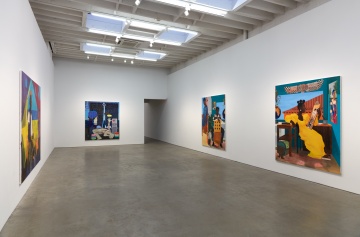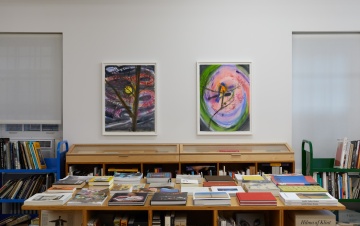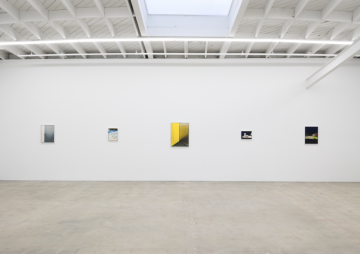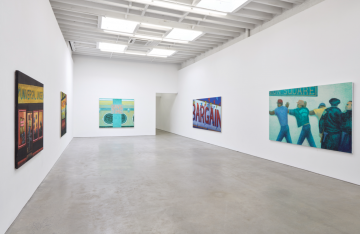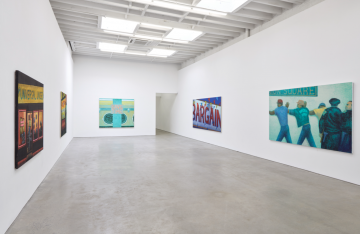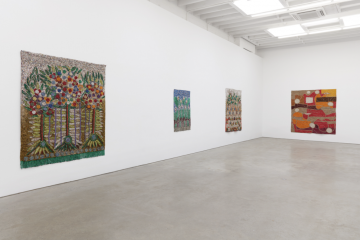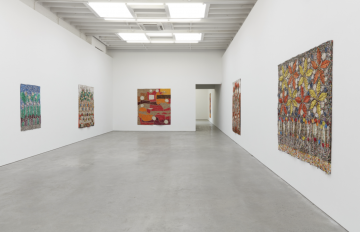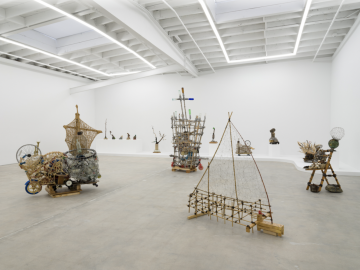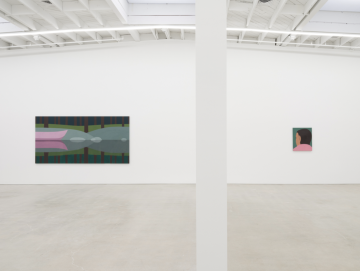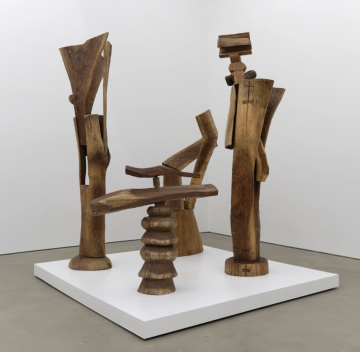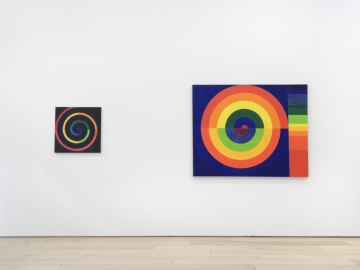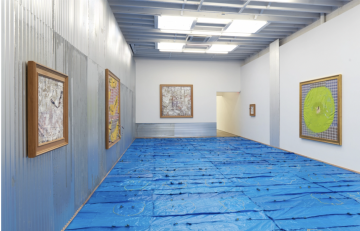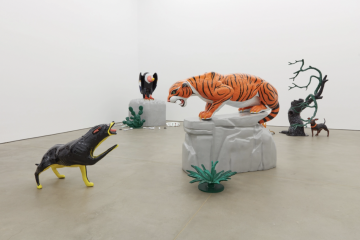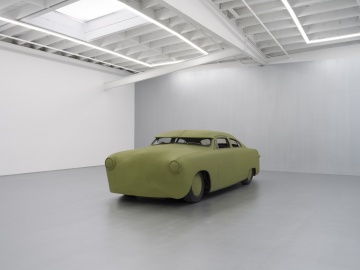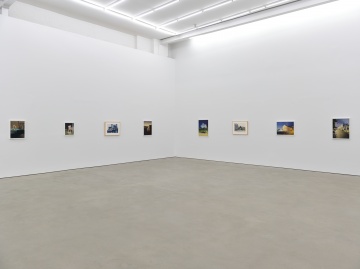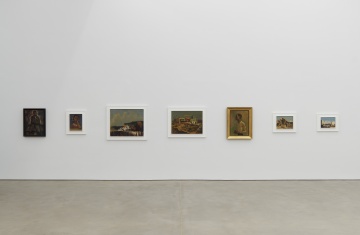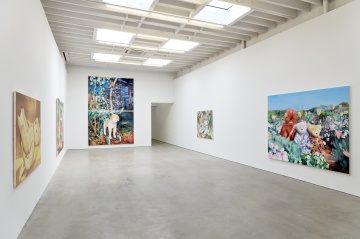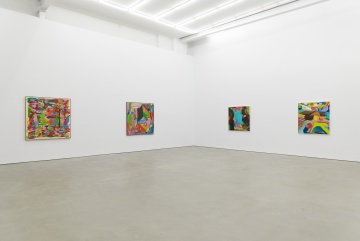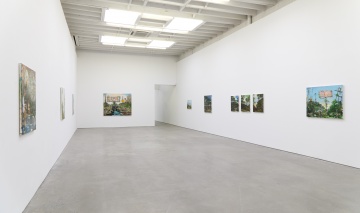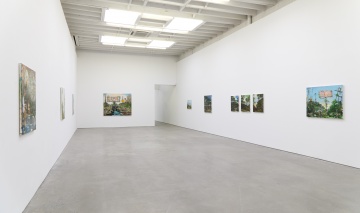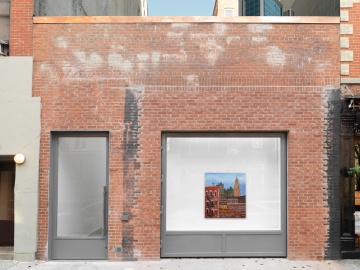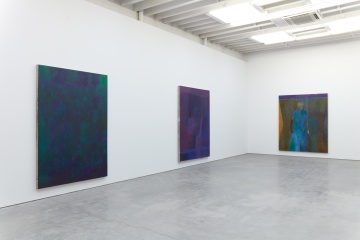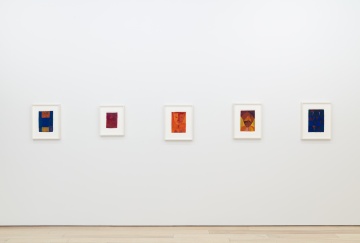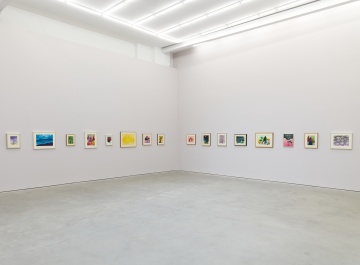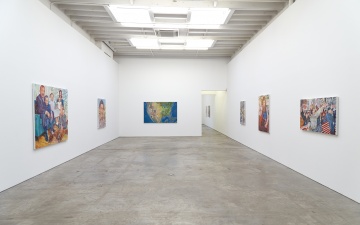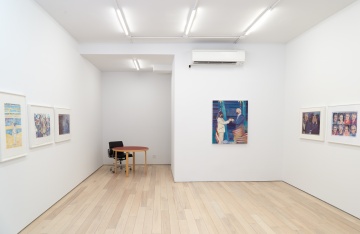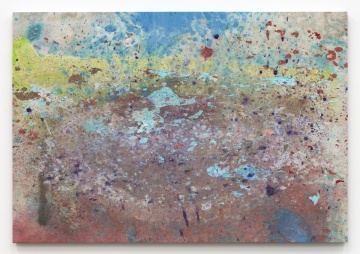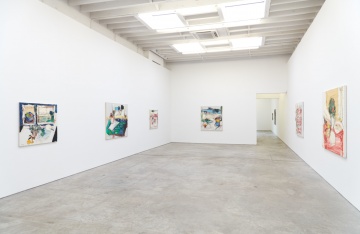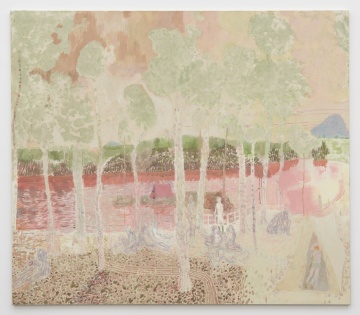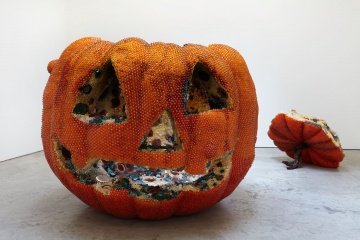Karma
188 East 2nd Street
New York, NY 10009
212 390 8290
Also at:
172 East 2nd Street
New York, NY 10009
212 390 8290
22 East 2nd Street
New York, NY 10003
212 390 8290
7351 Santa Monica Boulevard
Los Angeles, CA 90046
310 736 1367
Karma Bookstore
136 East 3rd Street
New York, NY 10009
212 390 9279
New York, NY 10009
212 390 8290
Also at:
172 East 2nd Street
New York, NY 10009
212 390 8290
22 East 2nd Street
New York, NY 10003
212 390 8290
7351 Santa Monica Boulevard
Los Angeles, CA 90046
310 736 1367
Karma Bookstore
136 East 3rd Street
New York, NY 10009
212 390 9279
Founded in 2011 by Brendan Dugan and currently located in NY’s East Village, Karma represents a diverse roster of multi-generational artists. The gallery hosts twenty exhibitions each year, many of which are accompanied by Karma-published monographs and artist books. In 2018, Karma opened its standalone bookstore that presents artist books and rare ephemera alongside the gallery's publications.
Works by the gallery’s artists are featured in numerous public collections including the Metropolitan Museum of Art, New York; Smithsonian American Art Museum, Washington D.C.; Stedelijk Museum Amsterdam; and Hammer Museum, Los Angeles, among others. In addition to its two gallery spaces, Karma’s third gallery location opened in the summer of 2021.
Artists Represented:
Gertrude Abercrombie
Henni Alftan
Alvaro Barrington
Dike Blair
Will Boone
Peter Bradley
Mathew Cerletty
Andrew Cranston
Ann Craven
Verne Dawson
Jane Dickson
Robert Duran
Louise Fishman
Mark Flood
Marley Freeman
Jeremy Frey
Sanaa Gateja
Robert Grosvenor
Peter Halley
Reggie Burrows Hodges
Ulala Imai
Paul Lee
Keith Mayerson
Paul Mogensen
Thaddeus Mosley
Nathaniel Oliver
Woody De Othello
Nicolas Party
Maja Ruznic
Kathleen Ryan
Alan Saret
Arthur Simms
Tabboo!
Mungo Thomson
Ouattara Watts
Xiao Jiang
Manoucher Yektai
Works Available By:
Gertrude Abercrombie
Henni Alftan
Alvaro Barrington
Dike Blair
Will Boone
Peter Bradley
Mathew Cerletty
Andrew Cranston
Ann Craven
Verne Dawson
Jane Dickson
Robert Duran
Louise Fishman
Mark Flood
Marley Freeman
Jeremy Frey
Sanaa Gateja
Robert Grosvenor
Peter Halley
Reggie Burrows Hodges
Ulala Imai
Paul Lee
Hughie Lee-Smith
Keith Mayerson
Paul Mogensen
Thaddeus Mosley
Nathaniel Oliver
Woody De Othello
Nicolas Party
Maja Ruznic
Kathleen Ryan
Alan Saret
Arthur Simms
Tabboo!
Mungo Thomson
Ouattara Watts
Matthew Wong
Xiao Jiang
Manoucher Yektai
Ouattara Watts
January 19, 2024 - March 16, 2024
Karma presents an exhibition of new paintings by Ouattara Watts, open from January 19 to March 16 at 7351 Santa Monica Boulevard, Los Angeles.
Over the course of nearly four decades and across three continents, Abidjan-born, New York–based artist Ouattara Watts has developed a painting practice that places cosmograms, numerals, cloth, and other symbols and relics from around the world into relation with each other, leveling hierarchies and creating new relations in the process. Alongside traditional media like acrylic and gouache, the artist embeds materials from a kaleidoscopic range of sources in his monumental, densely layered canvases: papier-mâché, fallen leaves, textiles gleaned from flea markets, and photographic reproductions, among others. The large-scale paintings on view here, all made in the last year in Watts’s Brooklyn studio, comprise the artist’s first-ever exhibition in Los Angeles.
As curator and scholar Okwui Enwezor, a champion of his work, wrote twenty years ago of the “postcolonial constellation” conjured by Watts in his canvases, the artist’s world is one of “discontinuous, aleatory forms, creolization, [and] hybridization . . . with a specific cosmopolitan accent.” The content of his work often gestures at his dual educations—as a young man in Côte d’Ivoire, the artist received an initiation into the animist religion of the Senufo people of West Africa; he later moved to Paris to study at L’École Nationale Supérieure des Beaux-Arts, where he began what would become a longstanding fascination with the Parisian modernists, particularly Pablo Picasso. Like Jean-Michel Basquiat, whom he met and befriended in 1988, Watts inserts his intricate, cipher-like forms into brilliant fields of color. The concept of fractality is foundational for the artist: fractal shapes, common to life forms across time and space, contain reduced-size copies of themselves within their structure, speaking to particularity and universality at the same time. Discussing his practice, Watts explains: “I think universally. . . about the history of the human soul. It’s not a history of clans, ethnic groups, or even artists, it’s what we can call the human condition.”
Watts alternates between working on the wall and the floor. Since the late 1990s, he has utilized drop cloths stained with acrylic as substrates for new paintings. Black and red marks stamped by the paint-covered treads of the artist’s shoes give Spiritual Gangster 02 an allover patterning reminiscent of Jackson Pollock, whose Number 1A, 1948 (1948) features his own handprint as autograph, and the broader legacy of Abstract Expressionism, one of many art-historical movements informing Watts’s painterly vernacular. These indexical traces suggest motion or tempo, evoking Watts’s abiding passion for music, which plays constantly in the studio and deeply influences his practice—like his paintings, music communicates universally while remaining a manifestation of a specific culture (or cultures).
Spiritual Gangster 01, which also features a background stained with splashes of paint, was inspired in part by sigui, a festival held once every six decades by the Dogon people of West Africa to honor the emergence of a new generation. The architectural and mask-like forms in this work tie directly to this practice. During sigui, which takes place when the star Sirius appears between two mountains, a select group of young men are secluded from the rest of the tribe, taught Sigi So, a secret dialect, and entrusted with the Great Mask, a meters-long, carved-wood object that serves as a ritual altar. Like Sigi So, Watts’s oeuvre speaks to the eternally renewing nature of existence in a mysterious language all its own.
Luigi Zuccheri
January 19, 2024 - March 16, 2024
Karma presents an exhibition of paintings by Luigi Zuccheri, open from January 19 to March 16 at 7351 Santa Monica Boulevard, Los Angeles.
Zuccheri’s postwar depictions of rural Northern Italy are at once faithful to naturalistic study and enchanted by an uncanny relationship to scale. The creatures that are the primary subjects of his egg tempera on wood panels have reclaimed the landscape from its flawed human occupants. A brush with Surrealism, an interest in Renaissance ex-voto tablets, and the influence of Metaphysical artists including his friend Giorgio de Chirico inform the paintings on display here. Though Zuccheri had several significant exhibitions in Italy during his lifetime—he was included in the 25th Venice Biennale and had regular solo shows at prestigious galleries in Turin and Milan—this presentation of works made between 1950 and 1955 constitutes the first exhibition of the Italian artist’s work in the United States.
Most fundamental to these lush scenes, however, was the artist’s experience resisting Nazi occupation in Friuli-Venezia Giulia and his resulting status as a fugitive during the final years of World War II. In the conflict’s aftermath, Zuccheri first found consolation in Catholicism, painting ex-votos (devotional works) on the walls of his home and illustrating the writings of saints Francis and Catherine. He soon returned to painting the natural world—a subject he had explored since his late teens. In order to better understand his nonhuman subjects, the artist became an amateur zoologist, exploring the two-hundred-square-mile Venetian Lagoon and its islands in a small sailboat and capturing specimens from which he painted and then returned to their environment.
The early 1950s, however, marked a surreal shift in scale. Using spirited-yet-careful brushstrokes redolent of post-Impressionism, Zuccheri depicted these mammals, amphibians, fish, and insects with rigorous attention to their anatomy and characteristic markings—but their odd proportions within the landscape undermine his studied realism. In one panel (all works untitled, ca. 1950–55), swaths of tempera create a barren landscape of rich umbers into which Zuccheri paints a walnut in between a mouse and a man of nearly equal stature; it is as if the artist has increased the size of the rodent so that he might precisely capture its glinting eyes, fixed on its prized nut, and round ears. The man, in contrast, has no discernable face.
During this period of artistic maturation, Zuccheri gave up the relatively modern practice of oil painting for the ancient medium of egg tempera, studying its techniques in fifteenth and sixteenth century books. By developing his own recipe for the medium, the artist was able to precisely control pigment density, paint thickness, and finish. Though tempera dries quickly and does not lend itself to smooth transitions between hues, Zuccheri embraced its distinctive formal qualities. To render the hare in the foreground of one painting, for example, the artist used a loose, almost Impressionistic cross-hatching technique to blend color. While all of his surfaces are matte, and often feature sections of densely built-up pigment, each retains an ethereal quality that is especially evident in the layers of glaze that constitute his depictions of billowing clouds opening to reveal luminous expanses of sky. Zuccheri’s attachment to the land is evident, too, in his palette—his distinctly muted, sepia-like tones resulted from his practice of grinding his own pigments from stones collected from local shorelines.
These works attest to his attunement to the forms of life that persist even as humans perpetrate violence against their own species. Zuccheri’s larger-than-life animals reveal his desire for nature to retake a landscape tainted by the social machinations of fascism. His scenes are depicted from the perspective of their creatural inhabitants, rather than those who seek to tame and exploit them. In one painting, a peasant trundles through the middleground, seemingly oblivious to the snake, beetle, and mushrooms that populate the fore. In another, slate-gray clouds part as if by some divine intervention to reveal a bright, clear sky that reflects in shimmering strokes on the lake and banks below it. A diminutive figure bends down to peer into the glassy water while another prepares to fish. In the composition’s bottom register, turtles and fish evade the threat of the hook’s snag as they move through the waves, undisturbed.
Robert Grosvenor
January 6, 2024 - March 2, 2024
Karma presents an exhibition of two new works by Robert Grosvenor, on view from January 6 to March 2 at 22 East 2nd Street, New York.
Horizontality defines much of Grosvenor’s enigmatic, five-decade-long oeuvre. At Karma, two materially distinct artworks, united in their horizontal orientation, share one gallery. A twelve-foot-long board, screwed laterally into the west wall at eye level, is obscured by a cloud of black spray paint. A low-slung, modified readymade occupies the center of the space. Together, they provoke a consideration of the relationship between the upright human body and these recumbent forms that nonetheless float above the ground.
Coated in deep-purple automobile paint, the central sculpture reflects its viewers in its gleaming surface. Where one expects a windshield, there is only open space. The hubcaps and headlights, like the wall sculpture, have been spray-painted matte black. A pair of vintage driving goggles are slung over the steering wheel, and a key decorated with a rabbit’s foot keychain dangles from in the ignition. These details push the otherwise objective sculpture to the edge of a narrative realm, implying the presence of a now-absent driver.
The second work presented here reprises a formal idiom Grosvenor last employed in 1970. A long, thin wooden beam hangs horizontally, activating the gallery’s architecture through linear extension. Its treatment with black paint, sprayed directly onto the wall, highlights the texture of the wood, creating a strong contrast with the pristine, industrial surface of the other work. From a distance, the board’s linear outline disappears into a diffuse cloud; up close, it reappears. As Hal Foster wrote of Grosvenor’s work in 1981, “its effect is one of sheer materialism, of a work of art absolutely given.”
Over years of consideration, Grosvenor discerns and executes subtle adjustments that transform objects into artworks. Augmenting readymades is a means of maximizing their formal appeal, a way to, in his words, “make things better.” His lifelong fascination with vehicles has recently developed into a sculptural practice: a modified speedboat, stripped of motor and steering wheel and treated with turquoise oil paint; a red scooter sited inside of a steel shipping container, the structure’s interior painted gold. By stripping away functionality, the artist places the emphasis entirely on formal relations of scale, material, line, and volume. In contrast with other recent vehicular artworks, this exhibition’s central sculpture is operational, much like his 1969 works Three Wheel Car, the earliest example in his practice of explicitly automotive forms. In each context, the interaction in space between viewer, artwork, and architecture is crucial. This is Karma’s fifth solo exhibition with the artist.
Nathaniel Oliver
My Journey Was Long So Yours Could Be Shorter
January 5, 2024 - March 2, 2024
Karma presents My Journey Was Long So That Yours Could Be Shorter, an exhibition of new paintings by Nathaniel Oliver, on view from January 5 to March 2 at 188 East 2nd Street, New York. This is Oliver’s first solo exhibition with the gallery.
Nathaniel Oliver’s narrative paintings build from our material world, extending into the realm of fantasy. The artist first develops his compositions by sketching from imagination, later adding specific images and objects from all corners of art history and his own life. Like a printmaker, Oliver constructs his paintings from discrete layers of uninterrupted color before adorning them with pattern and texture. His strategy is also one of accumulation—he conflates disparate representational styles, cutting and pasting from an encyclopedia of references, many of which belong to his personal canon of Black painting. Visual citations of West African culture appear—ranging from contemporary Malian textiles, to gris-gris charms from Sierra Leone, to Nigerian ceremonial masks—as do flora and fauna native to the Caribbean, where Oliver’s father was born. His works also foreground oceanic motifs, simultaneously evoking the centrality of the Atlantic to the artist’s upbringing near a wharf in Washington, DC, Homeric epic poetry, and the enduring legacies of the Middle Passage.
My Journey Was Long So That Yours Could Be Shorter points to the personal and societal struggles borne by generations in order to clear new paths for those who come after them. The world in which the exhibition’s paintings take place is parallel to our own, and contains some of its elements, yet remains outside of our timeline. The likenesses of its characters are based on friends and family members whom the artist thinks might suit each role, further confounding fact and fiction. Figures recur across multiple canvases, as if they walked out of one and stumbled into another.
In the dock scene At What Cost, Do I Stay or Go, a silhouetted figure tosses a roll of fairground tickets through the opening of a slightly parted curtain. The drapes, their patterns based on textiles from Mali, are suspended in space, untethered to any architecture of this world. A subway turnstile and a man holding a rooster in one hand and a knife in the other occupy the foreground. Beside them is a marble figure, its body bent deeply backwards, arms in an expressive position modeled on those made by marching band members. At What Cost, Do I Stay or Go is an allegory for the sacrifices necessary to pass from the corporeal world into the spiritual one. Who is granted access to transcendence, and who is denied?
In Would You Believe Me If I Showed You, a regal woman in a canary-yellow gown sits at a desk in front of a large open window that looks out on a terracotta roof top similar to those Oliver encountered while traveling in Lisbon. The artist adapted her pose—seated, in profile, drawing a sea monster on a sketch board—from a Baroque woodcut of the Greek prophetess Sibyl. A plank mask from the Bwa people of Burkina Faso and a painting of a Black knight drawn from a Renaissance altarpiece adorn the room’s walls. Her earrings are cowrie shells, a mollusk husk symbolizing prosperity that was used as currency in Africa for hundreds of years. Like Oliver, the female artist in Would You Believe Me If I Showed You is both a product of numerous cultures and the creator of a world all their own.
Norman Zammitt
Band Paintings 1973–1992
November 10, 2023 - January 13, 2024
Karma presents Norman Zammitt, Band Paintings 1973–1992, open from November 10, 2023, to January 6, 2024, at 7351 Santa Monica Boulevard, Los Angeles. This is the Los Angeles artist’s first solo exhibition in the city in over a decade.
For over twenty years, Zammitt worked from daybreak to sundown seven days a week in a former dance studio in Pasadena to create a series of horizontally striped canvases in numerous sizes that would come to be known as the Band Paintings. Using an idiosyncratic color-theory system of his own invention, the artist logarithmically calculated pigment weights precise to the thousandth of a gram, then suspended his mixtures in an acrylic medium. The transitions between stacked lines of colors project a luminosity as ethereal as the scattered rays of the sun. Inspired by and created in greater Los Angeles, the Band Paintings made their mark on the city: November 16, 2000, was officially “Norman Zammitt Day” in Los Angeles.
Zammitt and his family arrived in Southern California from Buffalo, New York, around 1945. Due to his mother’s membership in the Kanien’kehá:ka (Mohawk) nation of eastern Canada, he spent much of his early childhood living on the Kahnawá:ke Reservation near Montreal. In 1963, a faculty appointment at the University of New Mexico led to a yearlong stint in Albuquerque, after which Zammitt returned to greater Los Angeles, where he would live until his death in 2007. This spectrum of landscapes, and the varying qualities of natural light in each, informed the artist’s thinking about color as possessing an inherent vitality. As he would write following the Los Angeles County Museum of Art’s acquisition of his monumental Band Painting Untitled (The Elusive Eureka) (1977–78):“I had been thinking about the nature of color, most specifically, the sequential nature of color for most of my life. I was drawn to it, not by a decorative or superficial attraction but by something deep within the color, akin to the feeling of life itself.”
Zammitt entered the Los Angeles art world at a key moment in its history. His first major body of work after graduating in 1961 from the Otis Art Institute—a breeding ground for progressive art in that period—consisted of semi-transparent plexiglass sculptures that encase and refract layers of color. These early pieces are in conversation with the polyester resin works of Peter Alexander and John McCracken, among other artists working in modes that have since been categorized as Finish Fetish and Light and Space. The Band Paintings, many of which Zammitt made while referencing calculations from an Atari 800 computer program he developed with scholars from Pasadena’s California Institute of Technology, echo the mathematical precision of these art movements. These works also relate directly to the Hard-edge paintings that dominated the Los Angeles scene in the late 1950s in reaction to the gestural abstraction of the New York School.
Through paint alone, the Band Paintings achieve the radiance other artists were only able to create by manipulating light itself. Rather than figuratively depicting the sun as it moves through the sky, the Band Paintings engulf the viewer in its luminosity. ZBLKZAM.2D (1988) captures either the last moments of a sunset or the first of a sunrise as a thick band of inky blue slowly transitions into subsequently thinner gradations before grounding the composition in a thin gray horizon. BLACK.4 (1988) lends even a nocturnal palette a sense of weightlessness—remarkably, considering his works’ tonal depth, Zammitt never used black pigments. The searingly bright blue of Parabola Blue 3A/PB.3A (1989), on the other hand, evokes the quality of light filtered through a shallow tide pool. The dusky KKCC (1987) and NEW BLUE 5-A (1984) paintings, iterating within a range of dust-soaked blues, yellows, and reds, evince his attentiveness to the atmospheric subtleties of the Western landscape he called home for sixty-three years. “As long as I wake up in the morning and see the light pouring through my skylight here in California,” Zammitt wrote in 1981, “I am ready to work.”
Jonas Wood
Drawings 2003–2023
November 10, 2023 - January 13, 2024
Karma presents Drawings 2003–2023, a traveling survey of works on paper by Los Angeles–based artist Jonas Wood. The exhibition opened in June at Karma New York and is now on view from November 10, 2023, to January 6, 2024, at 7351 Santa Monica Boulevard, Los Angeles.
Drawings 2003–2023 assembles one hundred artworks, exhibited chronologically, in the largest survey of Jonas Wood’s works on paper to date. The exhibition begins with drawings made by the artist following his move to Los Angeles. While he established his studio practice in the city, Wood worked as an assistant to painter Laura Owens, and had his first solo exhibition with the storied Black Dragon Society gallery in 2006. During this time, Wood began to crystallize the distinctive visual language that would come to define his mature practice. An avid draftsman, drawings have myriad purposes for Wood, serving as either preparatory sketches for collages and paintings or stand-alone works of art.
At the heart of Wood’s prolific output is a reverence for the handmade: holding a found photograph in his hands, operating a manual projector, leaving behind a half-erased pencil sketch. In Plant 4 (2003), one in a series of drawings of potted plants that make up the earliest works in the exhibition, Wood’s delight in the tactility of mark-making is palpable: he used distinct strokes of crayon and spirited, imperfect shading to give shape to fields of blocky color, leaving behind an explicit citation of the hand of the artist: a single fingerprint. Works like Hunting With Mochi (2005), which depicts a cabin in the woods surrounded by a landscape made up of quilt-like patchworks of translucent color, exemplifies the influence of photo-collage on Wood’s practice. His drawings often begin with photographs, which he then cuts apart and re-composes into deliberately disjointed collages. Projecting the new, flattened-out, stylized image onto paper, Wood sketches its form using an array of media, including gouache, ink, charcoal, and ballpoint pen, producing a wide-angle lens effect that mimics the skewed proportions of memory.
In a 2008 essay, curator Cecilia Alemani describes Wood’s formal language as “a vernacular adaptation of color field painting inserted in the most mundane subjects.” This idiosyncratic hybridization of the everyday and art historical is clear in his work—such as Studio Shelf (2005), in which a skull, a favored subject of artistic movements such as Dutch Vanitas, is depicted alongside items including a mug, duct tape, and Color-aid swatches—and Hockney (2004), wherein the folds of a collared shirt become a site of modernist gesture, revealing a labyrinth of stratified grids. Hockney’s influence is clear in Wood’s loose gestural strokes, use of photo-collage, and scrupulous draftsmanship, and the younger artist’s admiration of his antecessor is also demonstrated in portrait homages. In 2005, Wood began depicting trading cards, which he describes as “ready-made portraits.” A prolific collector, the artist has amassed a formidable trove of sports memorabilia. One of numerous trading card portraits in the exhibition, Bo Jackson #2 (2018), a stencil-like portrayal of the baseball player within a black-and-white striated frame, evinces Wood’s engagement with the aesthetics of fan art. By treating the prosaic with sincerity and devotion, he reveals complexity and depth.
Over the course of the last two decades, Wood has considered and reconsidered architectural spaces—flattening and re-arranging them into distinct sections and adorning their walls with cultural signifiers. The artist approaches the titular paintings and the dark frame of an ornate molding in Two Picassos (2016), as well as a Matisse print and Panasonic television screen in Night Time T.V. Room with Janet (2021), with the same visual treatment, conflating both high art and everyday domesticity. In 2012, Wood first encountered the work of California-based ceramicist duo Magdalena Suarez Frimkess and Michael Frimkess. Like Wood, they delight in flattening references—Greco-Roman pottery and family photographs share pictorial space with Mickey and Minnie Mouse dancing the jitterbug—and a reverence for the handmade. Wood honors their output in works such as Frimkess Snoopy Pot with 33 on Plane (2023), a carefully rendered depiction of the nominal vessel in two-dimensions. In these homages to Frimkess, and in Wood’s practice more generally, the artist extends and plays with art historical lineages through devotional appropriation, always by hand.
To accompany the exhibition, Karma will publish a hardcover book that will feature a new essay by Douglas Fogle and a conversation between Jonas Wood and Laura Owens.
Mark Grotjahn
Skulls 2016–2023
November 3, 2023 - December 20, 2023
Karma presents Skulls 2016–2023, the first exhibition of Mark Grotjahn’s Skull paintings, open from November 3 to December 20 at 188 and 172 East 2nd Street, New York.
Perhaps it was inevitable that Grotjahn would arrive at the Skulls. After fifteen years of Face paintings and more than one hundred Mask sculptures, Grotjahn has stripped back the disguise and the skin and arrived at the inner layer of the head, the twenty-two bones that structure the human visage and protect the delicate brain. The artist recently noted that he has “to remember that I am a body,” not only a mind. By introducing a symbol of life’s inevitable end into his vocabulary of motifs, Grotjahn sets his sights on his own corporeality. As such, the Skulls are his most intimate paintings to date.
Grotjahn initiated this series of small-scale, intensely tactile works in 2016 as a riposte to his transcendental Capri paintings, developing them further while recovering from a massive blood clot in his leg and clots in both of his lungs at his home in Los Angeles in 2019. A backcountry skier who has spent the last few years widely exploring the mountain ranges of rural Colorado, Grotjahn regularly isolates himself completely in inhospitable terrains. Emerging from these experiences, his Skulls capture in oil on cardboard the feeling of uncontrollable natural forces. In one 2016 work, a burst of energy enters the composition from the right side, blasting white, red, and pink lines over and off of the simian figure’s cheeks and forehead and into the cerulean background.
In contrast with the anonymized, monochromatic skulls of Paul Cézanne’s late period, painted by the Impressionist after the death of his mother and as his own health began to deteriorate, Grotjahn’s takes on the subject infuse the macabre with a colorful vitality that upends their potentially grave associations. A 2019 painting features a wildly grinning visage surging forward with eyes blazing through a field of bubblegum pink. Another 2017 skull is wide-eyed and insistent, its mouth ajar as if arrested mid-sentence, as bursts of yellow and turquoise explode upward from its cranium. Teeming with impasto and made with brushes rather than the palette knife that has defined the artist’s recent output, these paintings affirm the influence of Post-Impressionists like Henri Matisse and Paul Gauguin, whose brilliant colors and clearly defined strokes pushed Impressionism to its breaking point.
While the Skulls all began as figurative drawings, Grotjahn’s myriad approaches and techniques yield a multitude of distinct representations. As Alison M. Gingeras writes in the catalogue that will accompany the exhibition, “Grotjahn’s pictorial systems allow him the latitude to oscillate between figurative referent and non-objective abstraction. With the Skulls, he establishes a similar framework to pursue permutations and mutations that occasionally drift radically away from his starting image.” The earliest works in the series are more clearly figurative—their subjects stand out against colorful grounds—while the more recent Skulls vacillate between dissolving inside of Grotjahn’s all-over daubs and re-emerging as image.
Confronted with the sprawling Untitled (Backcountry 55.46) (2023), a work from Grotjahn’s Colorado-inspired Backcountry series on view at 172 East Second Street, this cavalcade of crania assert themselves as tiny yet mighty. While the former series deals with nature’s boundlessness in sweeping palette-knife strokes that slash from one edge of the support to the other, mimicking the effect of skis cutting through snow, the Skulls are self-contained monads consisting of visible touches of brush to surface. Their buzzy contours describe figures working through the brevity of their time on earth, even as Grotjahn immortalizes them through painting.
Mark Grotjahn
Skulls 2016–2023
November 3, 2023 - December 20, 2023
Karma presents Skulls 2016–2023, the first exhibition of Mark Grotjahn’s Skull paintings, open from November 3 to December 20 at 188 and 172 East 2nd Street, New York.
Perhaps it was inevitable that Grotjahn would arrive at the Skulls. After fifteen years of Face paintings and more than one hundred Mask sculptures, Grotjahn has stripped back the disguise and the skin and arrived at the inner layer of the head, the twenty-two bones that structure the human visage and protect the delicate brain. The artist recently noted that he has “to remember that I am a body,” not only a mind. By introducing a symbol of life’s inevitable end into his vocabulary of motifs, Grotjahn sets his sights on his own corporeality. As such, the Skulls are his most intimate paintings to date.
Grotjahn initiated this series of small-scale, intensely tactile works in 2016 as a riposte to his transcendental Capri paintings, developing them further while recovering from a massive blood clot in his leg and clots in both of his lungs at his home in Los Angeles in 2019. A backcountry skier who has spent the last few years widely exploring the mountain ranges of rural Colorado, Grotjahn regularly isolates himself completely in inhospitable terrains. Emerging from these experiences, his Skulls capture in oil on cardboard the feeling of uncontrollable natural forces. In one 2016 work, a burst of energy enters the composition from the right side, blasting white, red, and pink lines over and off of the simian figure’s cheeks and forehead and into the cerulean background.
In contrast with the anonymized, monochromatic skulls of Paul Cézanne’s late period, painted by the Impressionist after the death of his mother and as his own health began to deteriorate, Grotjahn’s takes on the subject infuse the macabre with a colorful vitality that upends their potentially grave associations. A 2019 painting features a wildly grinning visage surging forward with eyes blazing through a field of bubblegum pink. Another 2017 skull is wide-eyed and insistent, its mouth ajar as if arrested mid-sentence, as bursts of yellow and turquoise explode upward from its cranium. Teeming with impasto and made with brushes rather than the palette knife that has defined the artist’s recent output, these paintings affirm the influence of Post-Impressionists like Henri Matisse and Paul Gauguin, whose brilliant colors and clearly defined strokes pushed Impressionism to its breaking point.
While the Skulls all began as figurative drawings, Grotjahn’s myriad approaches and techniques yield a multitude of distinct representations. As Alison M. Gingeras writes in the catalogue that will accompany the exhibition, “Grotjahn’s pictorial systems allow him the latitude to oscillate between figurative referent and non-objective abstraction. With the Skulls, he establishes a similar framework to pursue permutations and mutations that occasionally drift radically away from his starting image.” The earliest works in the series are more clearly figurative—their subjects stand out against colorful grounds—while the more recent Skulls vacillate between dissolving inside of Grotjahn’s all-over daubs and re-emerging as image.
Confronted with the sprawling Untitled (Backcountry 55.46) (2023), a work from Grotjahn’s Colorado-inspired Backcountry series on view at 172 East Second Street, this cavalcade of crania assert themselves as tiny yet mighty. While the former series deals with nature’s boundlessness in sweeping palette-knife strokes that slash from one edge of the support to the other, mimicking the effect of skis cutting through snow, the Skulls are self-contained monads consisting of visible touches of brush to surface. Their buzzy contours describe figures working through the brevity of their time on earth, even as Grotjahn immortalizes them through painting.
Ann Craven
Night
November 2, 2023 - December 20, 2023
Karma presents Night, an exhibition of new paintings by Ann Craven, open from November 2 to December 20 at 22 East 2nd Street, New York.
The eight nocturnal paintings in Night survey major motifs of Ann Craven’s nearly thirty-year-long practice. For the first time, she has set all of her scenes in the darkness of evening, creating a consistent chromatic background that intensifies her always-vibrant colors. Craven primarily approaches her subjects in one of two ways: painting from observation or from appropriated sources, both her own former compositions and images from books, postcards, movies, posters, and other painters, notably Georgia O’Keeffe. The methods are intimately connected, as she often scales up and repaints her small en plein air paintings in the studio. These oils of moons, trees, birds, flowers, and deer constitute the latest chapter in her systematic catalog of what she terms “revisitations,” each of which is also a reinvention of her subject matter.
Craven’s methodical revisitations emerge from material and psychic loss. In 1999, a fire decimated her studio, existing work, and personal belongings. Her efforts to recover from the catastrophe led to her first copies, canvases painted from memories of her prior works, and initiated a lifelong project of duplication and reiteration. Lacking a single fixed referent, her paintings multiply serially from the realms of emotion and memory. Each of the artist’s works contains within it the entire history of her practice, forming a link in an index of representations of representations. Marking the mysterious hours between sunset and sunrise, Night acknowledges the centrality of time’s passage in the artist’s oeuvre—the lag between perceiving an object and painting it, the movement from one canvas to the next, the continuous rotation of our earth.
In Night, Craven’s brushstrokes describe her subjects as feathery, lush, and brimming with vital energy and tender feelings. Fawn in Night Field, 2023 (all works 2023) depicts a sad-eyed doe against a sea of brushy grass shrouded in darkness, and yet elemental daisies in white and girlish pink emit an otherworldly illumination as they leave the ground and float hazily through the night sky. This fawn has been a friend of Craven’s since she first painted it in 1998, when she appropriated the original image from the 1973 dystopian science fiction film Soylent Green. Her choice of animal is also in conversation with Gustave Courbet’s epic Realist work The Death of the Stag (1867)—After the studio fire, a deer painting stored offsite was the sole Craven canvas that remained. As such, and in contrast with Courbet’s fatally wounded stag, her fawn represents courage, perseverance, and hope.
Portrait of a Blue Bird (Night Song, After Picabia), 2023 shows the titular creature with its beak agape, as if heralding the beauty of the jimsonweed flowers in the background. A mysterious, anatomically incorrect second eye disrupts the scene’s naturalism, bending it toward the surreal and distinguishing it from past iterations of the composition. The white blooms reference O’Keeffe’s own paintings of the flower, while the title’s nod to Picabia acknowledges inspiration Craven found in the French avant-gardist’s Transparencies (1927–33), paintings that layer art-historical references with portraiture and natural imagery—birds, animals, trees—into multivalent compositions. Behind another warbling, chesty Northern bluebird resting atop a blooming branch in Bold as Love, 2023 is a swirling vortex of pastels. This tempest of abstract color evokes the minimalist-yet-riotous Stripe canvases that Craven makes from the mixed oil paint that remains once she finishes a work from her oeuvre. The rarely-exhibited Stripes comprise an indexical archive that the artist, in her words, “naughtily” hides away from the world, preserving them for her own future reference. Bold as Love, 2023 reprises a painting she first exhibited in 2007, ten years after she began rendering specimens from an ornithology book discovered in the basement of her deceased grandmother’s Boston home.
The bouquet is one of the newest motifs in Night, originating only thirteen years ago. Craven’s marks in Dahlia’s (For the Pink Moon), 2023 feel immediate, as if unmediated transmissions from the artist’s eye to the canvas. Her wet-on-wet technique allows the petals of one flower to flow seamlessly into the next. Here, and across her practice, figuration morphs into kaleidoscopic abstraction and back again, each canvas resisting easy categorization in favor of pure feeling. Craven “is painting,” in the words of poet Ariana Reines, “desire itself.”
In Purple Beech (Night Sky), 2023, a glowing moon peeks through the dense foliage of the titular deciduous shade tree, while in Moon (Crazy 8 Green Clouds), 2023, the earth’s satellite radiates lavender rings of light as gusts of wind and the artist’s signature infinity-symbol-shaped clouds float by. Craven’s moons have been central to her cosmology since they formed the sole subject matter of her one-person debut exhibition in 1995. These lunar paintings originate in nights spent outdoors, closely observing the celestial body and capturing it on canvas in near-darkness, with only the memory of her palette guiding her brush. The eight monumental works are accompanied by corresponding, intimately-scaled oil paintings in the gallery’s viewing room, as well as a parallel group of watercolors on view at the Karma Bookstore at 136 East 3rd Street.
Ann Craven
Night
November 2, 2023 - December 20, 2023
Karma presents Night, an exhibition of new paintings by Ann Craven, open from November 2 to December 20 at 22 East 2nd Street, New York.
The eight nocturnal paintings in Night survey major motifs of Ann Craven’s nearly thirty-year-long practice. For the first time, she has set all of her scenes in the darkness of evening, creating a consistent chromatic background that intensifies her always-vibrant colors. Craven primarily approaches her subjects in one of two ways: painting from observation or from appropriated sources, both her own former compositions and images from books, postcards, movies, posters, and other painters, notably Georgia O’Keeffe. The methods are intimately connected, as she often scales up and repaints her small en plein air paintings in the studio. These oils of moons, trees, birds, flowers, and deer constitute the latest chapter in her systematic catalog of what she terms “revisitations,” each of which is also a reinvention of her subject matter.
Craven’s methodical revisitations emerge from material and psychic loss. In 1999, a fire decimated her studio, existing work, and personal belongings. Her efforts to recover from the catastrophe led to her first copies, canvases painted from memories of her prior works, and initiated a lifelong project of duplication and reiteration. Lacking a single fixed referent, her paintings multiply serially from the realms of emotion and memory. Each of the artist’s works contains within it the entire history of her practice, forming a link in an index of representations of representations. Marking the mysterious hours between sunset and sunrise, Night acknowledges the centrality of time’s passage in the artist’s oeuvre—the lag between perceiving an object and painting it, the movement from one canvas to the next, the continuous rotation of our earth.
In Night, Craven’s brushstrokes describe her subjects as feathery, lush, and brimming with vital energy and tender feelings. Fawn in Night Field, 2023 (all works 2023) depicts a sad-eyed doe against a sea of brushy grass shrouded in darkness, and yet elemental daisies in white and girlish pink emit an otherworldly illumination as they leave the ground and float hazily through the night sky. This fawn has been a friend of Craven’s since she first painted it in 1998, when she appropriated the original image from the 1973 dystopian science fiction film Soylent Green. Her choice of animal is also in conversation with Gustave Courbet’s epic Realist work The Death of the Stag (1867)—After the studio fire, a deer painting stored offsite was the sole Craven canvas that remained. As such, and in contrast with Courbet’s fatally wounded stag, her fawn represents courage, perseverance, and hope.
Portrait of a Blue Bird (Night Song, After Picabia), 2023 shows the titular creature with its beak agape, as if heralding the beauty of the jimsonweed flowers in the background. A mysterious, anatomically incorrect second eye disrupts the scene’s naturalism, bending it toward the surreal and distinguishing it from past iterations of the composition. The white blooms reference O’Keeffe’s own paintings of the flower, while the title’s nod to Picabia acknowledges inspiration Craven found in the French avant-gardist’s Transparencies (1927–33), paintings that layer art-historical references with portraiture and natural imagery—birds, animals, trees—into multivalent compositions. Behind another warbling, chesty Northern bluebird resting atop a blooming branch in Bold as Love, 2023 is a swirling vortex of pastels. This tempest of abstract color evokes the minimalist-yet-riotous Stripe canvases that Craven makes from the mixed oil paint that remains once she finishes a work from her oeuvre. The rarely-exhibited Stripes comprise an indexical archive that the artist, in her words, “naughtily” hides away from the world, preserving them for her own future reference. Bold as Love, 2023 reprises a painting she first exhibited in 2007, ten years after she began rendering specimens from an ornithology book discovered in the basement of her deceased grandmother’s Boston home.
The bouquet is one of the newest motifs in Night, originating only thirteen years ago. Craven’s marks in Dahlia’s (For the Pink Moon), 2023 feel immediate, as if unmediated transmissions from the artist’s eye to the canvas. Her wet-on-wet technique allows the petals of one flower to flow seamlessly into the next. Here, and across her practice, figuration morphs into kaleidoscopic abstraction and back again, each canvas resisting easy categorization in favor of pure feeling. Craven “is painting,” in the words of poet Ariana Reines, “desire itself.”
In Purple Beech (Night Sky), 2023, a glowing moon peeks through the dense foliage of the titular deciduous shade tree, while in Moon (Crazy 8 Green Clouds), 2023, the earth’s satellite radiates lavender rings of light as gusts of wind and the artist’s signature infinity-symbol-shaped clouds float by. Craven’s moons have been central to her cosmology since they formed the sole subject matter of her one-person debut exhibition in 1995. These lunar paintings originate in nights spent outdoors, closely observing the celestial body and capturing it on canvas in near-darkness, with only the memory of her palette guiding her brush. The eight monumental works are accompanied by corresponding, intimately-scaled oil paintings in the gallery’s viewing room, as well as a parallel group of watercolors on view at the Karma Bookstore at 136 East 3rd Street.
Maja Ruznic
Geometry of Exile
September 16, 2023 - November 4, 2023
Karma presents Geometry of Exile, an exhibition of new oil paintings by Maja Ruznic, open from September 16 to November 4 at 7351 Santa Monica Boulevard, Los Angeles. Geometry of Exile is Ruznic’s second exhibition with the gallery.
Born from her experiences of motherhood and displacement, Ruznic’s work peels back the layers of her own psyche. The artist begins each studio session by improvising with gouache on a small scale. Using what she describes as “muscle memory,” she builds on these works on paper to create her oversized canvases, whose orientation constantly changes as she scumbles oil paint onto the surface. By rotating her canvases, Ruznic twists her forms into spirals which radiate out from the paintings’ centers to confound any linear narrative. Colors resonate optically, but also reference her studies of mysticism and ritual—black, white, yellow, and red allude to the four humors of premodern medicine as well as the steps of alchemy’s magnum opus, the chemical process of transforming base material into gold.
In recent years, Ruznic has increased the number of layers of thinned-out paint to anywhere from three-to-fifteen passes of oil, causing her once diaphanous contours to solidify into denser, embodied forms. And yet, her figures and shapes still freely intermingle in a process of continuous becoming and dissolving. The Past, the Present and The Future in the Chest of One Man (2023) features an array of characters who wander through the fractured space of the painting, the boundaries of their multihued bodies freely interpenetrating and overlapping. A configuration of shapes merge to create a chimeric figure that structures the entire composition.
The multifaceted tones Ruznic creates through layering radiate a psychological depth appropriate for an artist fascinated with the multifarious unconscious. The combination of chartreuse, a turquoise, purple, and straw-yellow punctuated by flashes of red in the monumental painting March of Holographic Children (2023) is hallucinatory in its intensity. Blocky L-shapes read as feet stampeding their way across the bottom register while what look like bellies and pendulous breasts coalesce in the space above them. Full of forms associated with fertility and childbirth, March of Holographic Children is acidic and intimidating, as demanding as a newborn baby.
Spider Mother (2023) extends Ruznic’s consideration of the invisible labor of motherhood. Bulbous forms in a spectrum of ruddy orange-reds and earthy ochres surround a central carapace-like shape. Arcing lines reminiscent of an arachnid’s legs or a mammal’s ribcage radiate outward, where they meet rectangles of shifting color that act as a frame within the picture plane. Like Louise Bourgeois, one of her strongest influences, Ruznic employs the spider as a symbol of feminine creativity and industriousness. Spiders generate their silken homes from their own bodies and then use them to capture their prey; they have long been associated with creation as well as destruction. Spiderlike, Ruznic spins images that ensnare their viewers in complex forms, drawing us deeper into her syncretic vision of life and death.
Dike Blair
September 16, 2023 - November 4, 2023
Karma presents an exhibition of new oil paintings by Dike Blair, open from September 16 to November 4 at 7351 Santa Monica Boulevard, Los Angeles. Since the early 1980s, Blair has painted from his own photographs; the works on display are culled from images captured during the past decade. After using gouache exclusively for more than thirty years, he turned to oil, a medium that offers a wide range of surface effects, in 2017.
Blair’s works in both media approach the photoreal but stop short, concerned instead with capturing the way a moment can mark our memory. In his mise-en-scènes, everyday objects and architectures, both specific to the artist’s experience and universal in their lush appeal, are imbued with a mysterious frisson. The artist’s works may be autobiographical in nature, but they are not confessional—rather, they invoke a more expansive affective language. From the millions of split-second images that make up a life, he selects those that pose a painterly challenge, oscillating between compositions that center a nonhuman subject—coffee cups, blossoming flowers, cigarette packets, desserts, snacks—and those that disperse focus across a flat vista—windows, doors, fields of snow.
These point-and-shoot compositions suggest pure presentness, implicating the viewer in their intimacy by evoking sensorial pleasure. In Untitled (2022), a glass of brown liquor and another of water sit side by side on a bar, both glinting in their own particular way—an interplay of clementine-colored shards defines the pattern in the rocks glass while arcing strokes of desaturated mahogany and white lend the water’s vessel a tactile roundness. Looking at the painting, the viewer can nearly feel the contrast between the burn of the alcohol and the freshness of the chaser. Another characteristically untitled work from 2020 portrays the seam where a slate-gray door meets an off-white wall, the two sections held together by a barrel bolt in its locked position, and one can almost hear the satisfying clunk that comes with sliding the latch and releasing the tension holding it all together.
Blair’s focus on the affective qualities of light comes to the forefront in a 2023 painting of a darkened parking lot illuminated by twin spotlights. A pair of trees mirrors this doubling as they absorb the artificial rays into dense chartreuse foliage, leaving only a sliver of hazy radiance in the image’s middle ground to assert itself against the blackness of the sky and the cement. As Linda Norden has observed, Blair paints “not just the light as light, or the ostensible subject, but their mutual dependence.” From his immediate surroundings, Blair expropriates visual phenomena that reorient our relationship with what is right in front of our eyes.
Jane Dickson
Promised Land
September 9, 2023 - October 28, 2023
Karma presents Promised Land, an exhibition of new paintings and drawings by Jane Dickson, open from September 9 to October 28 at 188 and 172 East 2nd Street, New York. Dickson’s first show with the gallery, Promised Land features works focused on text and signage.
Dickson’s engagement with signage dates to the beginning of her artistic career in New York: Between 1978 and 1983, she designed and animated Times Square’s first digital billboard, the Spectacolor, while also living in the then-gritty neighborhood. Looking down from the window of her apartment or from the third floor of One Times Square, where she programmed the billboard, Dickson photographed the bustling intersection below, using the images as source material for paintings. In the forty-five years since, she has continued to paint from her photographs of street scenes, demolition derbies, strip clubs, circuses, suburban homes, and other charged social environments taken in cities across America. Recently, Dickson returned to this archival cache of negatives. Lightening under-exposed images, she pulled previously hidden imagery from their darkened recesses, seeing her past anew.
In Promised Land, Dickson reappropriated, re-edited, and reframed her photographs as paintings and drawings. These resulting works hone in on what signs reveal about the collective subconscious; in her words, text in the urban landscape reflects “what Americans are thinking, what we want and why we want it.” These translations of her anthropological photographs are both strongly graphic and dreamily diffuse. Her use of a variety of materials and surfaces, including but not limited to oil stick, acrylic, linen, and colored felt, lends each work a uniquely textured surface on which substrate and pigment collapse traditional notions of figure and ground.
Bargain (2023), a ten-foot-long composition in acrylic on felt, distills the false promise of capitalism into a single word and three primary colors. Triangular bunting, a familiar sight in car dealerships, swags off of the top of the sign and casts a shadow across its letters; the interaction between the acrylic paint and the wooly, fibrous background lends the forms an unstable vibration, as if emerging from the haze of memory. The titular neon sign in Save Time 2 (2022), an oil stick on linen depiction of a laundromat, posits time as a rare commodity. Through the phenomenon of optical color mixing, the artist’s monochromatic oil sticks create a range of fluorescent green and turquoise tones that offset the glowing orange lettering, contributing to an abiding atmosphere of alienation. Meanwhile, Dickson’s nocturnal paintings on black grounds represent figures as at once swallowed up by darkness and drenched in the blinding lights of marquees and advertisements, deindividuated by the city’s plentiful offerings of entertainment, nourishment, and comfort.
As Chris Kraus wrote twenty years ago, Dickson’s “eye is never very far removed from the tenuously middle-class state of echt-America where most people live two paychecks away from disaster.” Promised Land (2023), the exhibition’s namesake painting in acrylic on felt, features a sign advertising quick payouts but leaves open the question of what exactly is being bought and sold. Dickson’s new depictions of our cultural sigils suggest that all American promises have an unavoidable, often invisible psychic price.
Jane Dickson
Promised Land
September 9, 2023 - October 28, 2023
Karma presents Promised Land, an exhibition of new paintings and drawings by Jane Dickson, open from September 9 to October 28 at 188 and 172 East 2nd Street, New York. Dickson’s first show with the gallery, Promised Land features works focused on text and signage.
Dickson’s engagement with signage dates to the beginning of her artistic career in New York: Between 1978 and 1983, she designed and animated Times Square’s first digital billboard, the Spectacolor, while also living in the then-gritty neighborhood. Looking down from the window of her apartment or from the third floor of One Times Square, where she programmed the billboard, Dickson photographed the bustling intersection below, using the images as source material for paintings. In the forty-five years since, she has continued to paint from her photographs of street scenes, demolition derbies, strip clubs, circuses, suburban homes, and other charged social environments taken in cities across America. Recently, Dickson returned to this archival cache of negatives. Lightening under-exposed images, she pulled previously hidden imagery from their darkened recesses, seeing her past anew.
In Promised Land, Dickson reappropriated, re-edited, and reframed her photographs as paintings and drawings. These resulting works hone in on what signs reveal about the collective subconscious; in her words, text in the urban landscape reflects “what Americans are thinking, what we want and why we want it.” These translations of her anthropological photographs are both strongly graphic and dreamily diffuse. Her use of a variety of materials and surfaces, including but not limited to oil stick, acrylic, linen, and colored felt, lends each work a uniquely textured surface on which substrate and pigment collapse traditional notions of figure and ground.
Bargain (2023), a ten-foot-long composition in acrylic on felt, distills the false promise of capitalism into a single word and three primary colors. Triangular bunting, a familiar sight in car dealerships, swags off of the top of the sign and casts a shadow across its letters; the interaction between the acrylic paint and the wooly, fibrous background lends the forms an unstable vibration, as if emerging from the haze of memory. The titular neon sign in Save Time 2 (2022), an oil stick on linen depiction of a laundromat, posits time as a rare commodity. Through the phenomenon of optical color mixing, the artist’s monochromatic oil sticks create a range of fluorescent green and turquoise tones that offset the glowing orange lettering, contributing to an abiding atmosphere of alienation. Meanwhile, Dickson’s nocturnal paintings on black grounds represent figures as at once swallowed up by darkness and drenched in the blinding lights of marquees and advertisements, deindividuated by the city’s plentiful offerings of entertainment, nourishment, and comfort.
As Chris Kraus wrote twenty years ago, Dickson’s “eye is never very far removed from the tenuously middle-class state of echt-America where most people live two paychecks away from disaster.” Promised Land (2023), the exhibition’s namesake painting in acrylic on felt, features a sign advertising quick payouts but leaves open the question of what exactly is being bought and sold. Dickson’s new depictions of our cultural sigils suggest that all American promises have an unavoidable, often invisible psychic price.
Kathleen Ryan
Shell
September 9, 2023 - October 28, 2023
Karma presents Shell, a new sculpture by Kathleen Ryan, on view at 22 East 2nd Street, New York, from September 9 to October 28, 2023.
A curved, yawning mouth, glistening pink tongue extending downward, gently licking the pedestal. Or perhaps the inside of a stomach, undulating as if straining to digest. A vast cavity, buffed from jagged peaks of rose quartz into a silky epidermis. Following the tip of the tongue into the hollow gut of Kathleen Ryan’s Shell (2023), a large-scale sculpture assembled from discarded car parts, feels uncannily like exploring the vulnerable innards of your own body.
The exterior, braided into the shape of a shell with strips of old fenders, their own paint skins stripped and burnished, rests in the center of the gallery like some prehistoric carcass, dragged out of the ebony ocean depths. This hulking, spiraled body is both ancient and futuristic, unraveling time in ways both destabilizing and beguiling. Sockets where headlights once sat offer glimpses into a pink, rippling landscape. As in other works by the artist, art historical predecessors are invoked with both due respect and a wink. Even while recalling the contorted-automobile sculptures of John Chamberlain and the ocular, velveteen-lined constructions of Lee Bontecou, Ryan’s Shell is an icon all its own. Industrial materials here are somehow more organic than nature itself. While the rust coating the steel brings to mind human obsolescence, this is not some apocalyptic omen. Something less sinister has taken place: a transformation. Water and air have reclaimed the manufactured as just another element of nature. Rust is porous, like skin; ochers, reds, and browns bloom like so many flowers from what was once sterile chrome. The artist has participated in this alchemy, too. Seemingly inflexible steel has been twisted and stitched together as carefully as a quilt. Rose quartz, a mineral thought to have healing properties, has been carved and polished to a smooth, glinting luster—its rocky edges now supple and corporeal.
Crouching, sitting, and lying in the belly of Shell while grinding and sanding its interior, Ryan inhabited her own creation. Slowly, mollusks construct their own protective exoskeletons, that is, the shells that house them. A shell is both a protective structure and shelter, formed out of a symbiotic, or mutually necessary relationship. Soft bodies, hard shells: Ryan’s work calls into question the hierarchies between strength and delicateness. Here, hard, defensive materials are porous, responsive, iterative. Silky insides are as resilient as steel. In the act of inhabiting, a body alters the very makeup of its dwelling. Vulnerability becomes an act of creation. Hard bodies, soft shells.
Thaddeus Mosley
Recent Sculpture
July 15, 2023 - September 9, 2023
Karma presents Recent Sculpture, a solo exhibition of sculptures by Thaddeus Mosley, on view from July 15 to September 9, 2023, at 7351 Santa Monica Boulevard, Los Angeles.
For the first time, bronze sculptures by Mosley will be presented alongside his hand-carved works in wood, all of which were created in the last three years. Since the late 1950s, the artist has transformed felled urban hardwoods such as walnut, cherry, and chestnut into totemic, multipart sculptures using only a mallet and chisel. In 2020, Mosley began working in bronze in order to bring his sculptures to life outdoors. He first displayed them at the plaza at New York’s Rockefeller Center that same year, followed by a 2021–22 installation outside of the Harvard Business School. In 2022, Mosley brought them to Paris’s Musée National Eugène Delacroix, where they were displayed in the French artist’s garden. Cast from the wooden sculptures and meticulously patinated to match the natural gradations of their surfaces, these bronzes immortalize Mosley’s organic artworks in a non-corrodible material, facilitating a return to their sylvan origins.
Weighing several hundred pounds more than their wooden counterparts, these metal sculptures nevertheless seem to float. This duality of heft and levity, precarity and monumentality, makes manifest the principle Mosley has termed “weight in space,” in which unwieldy materials are sculpted and arranged so as to appear to levitate. The translation from wood to bronze only underscores the works’ semblance of weightlessness. In Region in Suspension (2020), a thin, planar segment cradled between two columns rises upward. This feat of balance—both aesthetic and physical—invokes the ancient architectural technique of post and lintel, in which heavy horizontal elements are upheld by vertical pillars. The hewn surface of the work, preserved in bronze, tells the story of its own responsive and spontaneous creation. The artist likens this process of working with wood to the “essence of good jazz.” For Hinged Bastion (2020), a freestanding work composed solely of walnut, Mosley exposes the various hues latent in the wood’s layers by leaving two knotty surface burls unaltered. Angular segments crescendo in a seemingly-gravity defying intersection in Repetitive Reference (2020), together forming a lyrical and harmonious whole.
In the bronze work Branched Form (2020), four curving tines grasp at the air above their slender base as if striking a pose, while undulating lines of chisel marks catch the light and draw the eye up and around the sculpture. As Mosley has noted, “My sculpture, the beauty of it, for me, is the textures that direct your eye and give a sense of rhythm . . . and vitality to the piece. I like the evidence of the hand, evidence of the tool.” The artist utilizes lost-wax casting—an ancient, highly sensitive metalworking technique in which a mold made from an original sculpture yields a wax replica, which is then covered in a second fireproof mold and burned out with molten metal. As a result, these bronze iterations precisely echo each of Mosley’s marks and retain their sense of vitality. Viewed together, Mosley’s works in wood and bronze reveal new elements at each angle—a dance between form and void, space and time, organic and man-made.
Thaddeus Mosley (b. 1926, New Castle, Pennsylvania) is a Pittsburgh-based sculptor working primarily in wood and bronze. Thaddeus Mosley: Forest, which first opened in 2022 at the Baltimore Museum of Art and subsequently traveled to Art+Practice, Los Angeles, is currently on view at the Nasher Sculpture Center, Dallas. Mosley’s work is also presently included in the exhibition Inheritance at the Whitney Museum of American Art, New York, on view through February 2024. In 2022, his work was presented in the exhibition La Suite de l’Histoire at the Musée National Eugène Delacroix, Paris. In that same year, Mosley was the recipient of the 2022 Isamu Noguchi prize. His work is held in the collections of institutions such as the Baltimore Museum of Art, Maryland; the Art Institute of Chicago; High Museum of Art, Atlanta, Georgia; Whitney Museum of American Art, New York; Brooklyn Museum, New York; and the Colby College Museum of Art, Waterville, Maine.
Tabboo!
Nothing but blue skies from now on
July 15, 2023 - September 9, 2023
Karma presents Nothing but blue skies from now on, an exhibition of recent paintings by Tabboo!. The exhibition is Tabboo!’s first in Los Angeles and will run from July 15 through September 9.
Building on Tabboo!’s decades-long exploration of landscape and the flora and fauna that populate it, this body of work extends his focus to a new setting: nominally, Los Angeles and its surrounding area, but in the artist’s terms, “the Hollywood imaginary.” Tabboo! takes subjects grounded in reality as his starting point, transforming them in his signature style, which he terms “emotional realism.” He embraces the fantasies projected onto the sites that he depicts; in his words, he favors “the visual, the memory, the idea” of Los Angeles over its gritty reality. The exhibition takes its title from the lyrics of Irving Berlin’s 1926 song “Blue Skies,” famous for its juxtaposition of exuberant verses and a discordant minor key. Exploring subjects such as cacti blooming by city sidewalks, the sun setting over the Pacific Ocean, and iconic signs and landmarks, these paintings similarly play with affective ambiguity—is that a golden glow, or smog?
Tabboo! paints on unprimed canvas, using aqueous pigment to develop vivid color fields as the ground for his subjects. While referencing the formal techniques of color field painters who foregrounded color itself as subject, Tabboo! uses color as a catalyst to convey affect and intimacy. Oranges, ranging from tangerine to burnt umber, dominate the palette in several landscape works, recalling both the “Golden” Age of Hollywood glamor and Los Angeles’ iconic sunsets. In works such as California Sunset and Bright Orange Sunset, Tabboo! uses horizontal strokes and translucent pigment to portray hazy, rolling hills and smoldering dusk. This body of work explores the panoramic and immersive effects of a horizontal picture plane. The landscape perspective harkens back to Tabboo!’s artistic beginnings hand-painting backdrops for drag performances at New York’s storied Pyramid Club. The concept of the backdrop or film set is implicit in the works in Nothing but blue skies from now on, intended not to shift reality itself but rather to revision it in more vibrant hues—a gilded mirage.
The artist explores the hazy threshold between city and wilderness, as well as between memory and reality, in works such as Hollywood, in which palm trees in parallel columns vanish into the horizon, the iconic sign appearing within the veil of distance. In the largest work in the exhibition, Griffith Observatory, the city rests in a valley of blue shadows, framed by an evocative swath of incandescent sky. Atop a brushy hillside sits the observatory, its sights poised for the transition into night. In all its exuberance of gesture, Nothing but blue skies from now on is a flight into the senses and the Hollywood cosmos. This is the world both as Tabboo! sees it and how he wants it: brimming with color and containing no small amount of magic.
Tabboo! (Stephen Tashjian, b. 1959, Leicester, MA) is a multidisciplinary artist and painter based in New York City. He renders his subjects in a direct, intuitive style, suspending figurative elements against dreamlike colorfields. Tabboo! often draws subjects from his surroundings, depicting expressive cityscapes, portraits of friends, or imaginative still lifes inspired by the plants in his apartment. He also paints large, panoramic works and site-specific murals. These immersive settings recall the painted backdrops he made for performances in the 1980s and 1990s. While performing regularly himself, Tabboo! also designed numerous event fliers, posters, and album covers featuring his signature curvilinear text, which still appears in his work. Roberta Smith described Tabboo!’s paintings as “delicious, fresh and transparent, revealing every touch of color, every pour and drip.” His work is held in the collections of the Whitney Museum of American Art, New York; the Hammer Museum, Los Angeles; the Institute of Contemporary Art, Miami, Florida: and the Museum of Fine Arts, Houston, Texas.
Jonas Wood
Drawings 2003–2023
June 28, 2023 - August 18, 2023
Karma presents Drawings 2003–2023, a survey of works on paper by Los Angeles–based artist Jonas Wood.
Drawings 2003–2023 assembles one hundred artworks, exhibited chronologically, in the largest survey of Jonas Wood’s works on paper to date. The exhibition begins with drawings made by the artist following his move to Los Angeles. While he established his studio practice in the city, Wood worked as an assistant to painter Laura Owens, and had his first solo exhibition with the storied Black Dragon Society gallery in 2006. During this time, Wood began to crystallize the distinctive visual language that would come to define his mature practice. An avid draftsman, drawings have myriad purposes for Wood, serving as either preparatory sketches for collages and paintings or stand-alone works of art.
At the heart of Wood’s prolific output is a reverence for the handmade: holding a found photograph in his hands, operating a manual projector, leaving behind a half-erased pencil sketch. In Plant 4 (2003), one in a series of drawings of potted plants that make up the earliest works in the exhibition, Wood’s delight in the tactility of mark-making is palpable: he used distinct strokes of crayon and spirited, imperfect shading to give shape to fields of blocky color, leaving behind an explicit citation of the hand of the artist: a single fingerprint. Works like Hunting With Mochi (2005), which depicts a cabin in the woods surrounded by a landscape made up of quilt-like patchworks of translucent color, exemplifies the influence of photo-collage on Wood’s practice. His drawings often begin with photographs, which he then cuts apart and re-composes into deliberately disjointed collages. Projecting the new, flattened-out, stylized image onto paper, Wood sketches its form using an array of media, including gouache, ink, charcoal, and ballpoint pen, producing a wide-angle lens effect that mimics the skewed proportions of memory.
In a 2008 essay, curator Cecilia Alemani describes Wood’s formal language as “a vernacular adaptation of color field painting inserted in the most mundane subjects.” This idiosyncratic hybridization of the everyday and art historical is clear in his work—such as Studio Shelf (2005), in which a skull, a favored subject of artistic movements such as Dutch Vanitas, is depicted alongside items including a mug, duct tape, and Color-aid swatches—and Hockney (2004), wherein the folds of a collared shirt become a site of modernist gesture, revealing a labyrinth of stratified grids. Hockney’s influence is clear in Wood’s loose gestural strokes, use of photo-collage, and scrupulous draftsmanship, and the younger artist’s admiration of his antecessor is also demonstrated in portrait homages. In 2005, Wood began depicting trading cards, which he describes as “ready-made portraits.” A prolific collector, the artist has amassed a formidable trove of sports memorabilia. One of numerous trading card portraits in the exhibition, Bo Jackson #2 (2018), a stencil-like portrayal of the baseball player within a black-and-white striated frame, evinces Wood’s engagement with the aesthetics of fan art. By treating the prosaic with sincerity and devotion, he reveals complexity and depth.
Over the course of the last two decades, Wood has considered and reconsidered architectural spaces—flattening and re-arranging them into distinct sections and adorning their walls with cultural signifiers. The artist approaches the titular paintings and the dark frame of an ornate molding in Two Picassos (2016), as well as a Matisse print and Panasonic television screen in Night Time T.V. Room with Janet (2021), with the same visual treatment, conflating both high art and everyday domesticity. In 2012, Wood first encountered the work of California-based ceramicist duo Michael and Magdalena Suarez Frimkess. Like Wood, they delight in flattening references—Greco-Roman pottery and family photographs share pictorial space with Mickey and Minnie Mouse dancing the jitterbug—and a reverence for the handmade. Wood honors their output in works such as Frimkess Snoopy Pot with 33 on Plane (2023), a carefully rendered depiction of the nominal vessel in two-dimensions. In these homages to Frimkess, and in Wood’s practice more generally, the artist extends and plays with art historical lineages through devotional appropriation, always by hand.
To accompany the exhibition, Karma will publish a hardcover book that will feature a new essay by Douglas Fogle and a conversation between Jonas Wood and Laura Owens.
Jonas Wood (b. 1977, Boston) is a Los Angeles–based artist. In 2010, Wood had his first solo museum exhibition at the Hammer Museum in Los Angeles, which was followed by a number of public commissions, including murals for the High Line, New York (2014) and works for the facades of LAXART, Los Angeles (2014), and the Museum of Contemporary Art, Los Angeles (2016–18). In 2017, Museum Voorlinden in the Netherlands presented a two-person exhibition between Jonas Wood and Shio Kusaka. In 2019, the Dallas Museum of Art presented the first major survey of Wood’s work.
Sanaa Gateja
Rolled Secrets
June 27, 2023 - August 18, 2023
Karma presents Rolled Secrets, Sanaa Gateja’s first solo exhibition in New York, following his inclusion in the 58th Carnegie International.
Gateja transforms natural materials and post-consumer paper waste into complex, mosaic-like works. Using materials such as hand-rolled paper beads and cloth made from soaked and pounded strips of inner bark, the Uganda-based artist merges fiber art, installation, painting, and sculpture. The beads, sourced from recycled paper, are first hand-rolled and cut to form and then sewn onto the barkcloth to create intricate compositions. Motivated by an innate sensibility of form, Gateja’s often monumental works oscillate between figuration and abstraction. Up close, the beads offer glimpses, between delicate folds, of their past lives—as vintage posters, pages from wig sales pamphlets, and outdated textbooks. To realize these works, Gateja engages a wealth of communal resources and traditional Ugandan methods of beading, weaving, and basketry.
The exhibition highlights two series, Rolled Secrets (2023) and Paths: The African Journey (2020). The works that comprise Rolled Secrets are primarily figurative, and often feature intricate depictions of forest settings and social gatherings, as well as beaded fringes. Gateja’s focus on trees extends beyond their form and into their complex, interconnected relationships with their surroundings—from their deep root systems to branches laden with bright leaves and multicolored fruit, as in Ripe (2022). In Voice of Peace (2023), a thicket of green and orange beadwork coalesces to depict figures and signifiers of nature—separate elements unified by rounded forms, leaves, and feather-like adornments. In Realisation (2023), a dense array of colored orbs creates a vibrant middle ground that extends upward into thin, plant-like forms and cascades downward into kaleidoscopic beaded fringes. In Paths: The African Journey, Gateja employs a more unified palette of pinks, yellows, and ocher, contrasted by rivulets of pale-colored beads, to explore the history of Africa—specifically the forces of colonization, enslavement, and the resilience of the continent’s population and diaspora. Although emphasizing abstraction, Gateja’s oeuvre draws affective connections between people and their environment. In works such as Self Sufficiency (2020) and Visiting (2020), the jostle between smooth peaks and rounded forms simultaneously suggests figures and rural topographies; the same details that evoke outstretched arms and welcoming faces are also reminiscent of grasslands and mountain passes seen from above. In these two bodies of work, Gateja articulates a kind of visual alchemy, in which art-making becomes an act of environmental and spiritual repair.
Sanaa Gateja (b. 1950; Kisoro, Uganda) has been working with recycled paper beads since 1990, a process he describes as “Art for Development.” The production of the materials provides sustainable employment for craftswomen across Uganda. Gateja’s work was featured in the 58th Carnegie International in Pittsburgh (2022–23) and has been exhibited extensively across Africa and internationally, including at the Museum of Arts and Design, New York (2010).
Sanaa Gateja
Rolled Secrets
June 27, 2023 - August 18, 2023
Karma presents Rolled Secrets, Sanaa Gateja’s first solo exhibition in New York, following his inclusion in the 58th Carnegie International.
Gateja transforms natural materials and post-consumer paper waste into complex, mosaic-like works. Using materials such as hand-rolled paper beads and cloth made from soaked and pounded strips of inner bark, the Uganda-based artist merges fiber art, installation, painting, and sculpture. The beads, sourced from recycled paper, are first hand-rolled and cut to form and then sewn onto the barkcloth to create intricate compositions. Motivated by an innate sensibility of form, Gateja’s often monumental works oscillate between figuration and abstraction. Up close, the beads offer glimpses, between delicate folds, of their past lives—as vintage posters, pages from wig sales pamphlets, and outdated textbooks. To realize these works, Gateja engages a wealth of communal resources and traditional Ugandan methods of beading, weaving, and basketry.
The exhibition highlights two series, Rolled Secrets (2023) and Paths: The African Journey (2020). The works that comprise Rolled Secrets are primarily figurative, and often feature intricate depictions of forest settings and social gatherings, as well as beaded fringes. Gateja’s focus on trees extends beyond their form and into their complex, interconnected relationships with their surroundings—from their deep root systems to branches laden with bright leaves and multicolored fruit, as in Ripe (2022). In Voice of Peace (2023), a thicket of green and orange beadwork coalesces to depict figures and signifiers of nature—separate elements unified by rounded forms, leaves, and feather-like adornments. In Realisation (2023), a dense array of colored orbs creates a vibrant middle ground that extends upward into thin, plant-like forms and cascades downward into kaleidoscopic beaded fringes. In Paths: The African Journey, Gateja employs a more unified palette of pinks, yellows, and ocher, contrasted by rivulets of pale-colored beads, to explore the history of Africa—specifically the forces of colonization, enslavement, and the resilience of the continent’s population and diaspora. Although emphasizing abstraction, Gateja’s oeuvre draws affective connections between people and their environment. In works such as Self Sufficiency (2020) and Visiting (2020), the jostle between smooth peaks and rounded forms simultaneously suggests figures and rural topographies; the same details that evoke outstretched arms and welcoming faces are also reminiscent of grasslands and mountain passes seen from above. In these two bodies of work, Gateja articulates a kind of visual alchemy, in which art-making becomes an act of environmental and spiritual repair.
Sanaa Gateja (b. 1950; Kisoro, Uganda) has been working with recycled paper beads since 1990, a process he describes as “Art for Development.” The production of the materials provides sustainable employment for craftswomen across Uganda. Gateja’s work was featured in the 58th Carnegie International in Pittsburgh (2022–23) and has been exhibited extensively across Africa and internationally, including at the Museum of Arts and Design, New York (2010).
Marley Freeman and Lukas Geronimas
Miniatures
June 2, 2023 - July 7, 2023
Karma presents Miniatures, a two-person show of works by sculptor Lukas Geronimas and painter Marley Freeman, on view from June 2 to July 7, 2023, at Karma’s bookstore, 136 East 3rd Street, New York.
In Miniatures, Freeman’s small-scale, abstract paintings of layered and woven color are presented alongside Geronimas’s lustrous, playful brass and wood sculptures. In addition to pieces by each artist, this exhibition also features collaborations, which the artists created by sending works to each other by mail. For these, Freeman painted directly on the surface of several of Geronimas’s sculptures, and he in turn made artist’s frames for a series of her works on linen.
The following email exchange between the two artists describes the history and impact of their collaborations:
LUKAS GERONIMAS: Marley has been a painter since I’ve known her. I’m a fan of painting, but would never identify as a painter—mine is the world of objects. Objects can be painted on, and paintings can be tied to the wall by way of objects, so this all makes sense for the two of us. I know Marley well, I know a lot of things about her, but I’ll never know what exactly she’s doing in her paintings—the mechanics are evident but elusive. We get along great, our work gets along well too.
The thing that’s great about teaming up with Marley is that I can’t do the things she can do with an artwork, and she can’t do the things I can do, so the collaborative results are things neither of us could have done. I don’t think the result of our collaborations are better than our works made individually, but they arrive at a meaningful expression by way of a more complex mode; two instruments for one result. In this show we have pairings, and designated—or authorized—collaborations. You can see us playing our instruments next to each other, and you can see us playing our instruments with each other.
MARLEY FREEMAN: I love the way Lukas works with materials. It feels like he can make anything out of anything. I also love that our working relationship is very natural. This is not a labored collaboration. There’s no notes or discussions. Just general warm expressions and packages. As a New York–based art worker the people I have often been closest to have been either roommates or co-workers. And Lukas fits snuggly in this category. We relate through making.
Emma Amos, Ida Applebroog, Jennifer Bartlett, Betty Blayton, Vivian Browne, Cynthia Carlson, Martha Diamond, Louise Fishman, Suzan Frecon, Nancy Graves, Cynthia Hawkins, Mary Heilmann, Virginia Jaramillo, Jane Kaplowitz, Harriet Korman, Lois Lane, Helen Marden, Dindga McCannon, Ree Morton, Elizabeth Murray, Ellen Phelan, Howardena Pindell, Sylvia Plimack Mangold, Faith Ringgold, Dorothea Rockburne, Susan Rothenberg, Joan Semmel, Jenny Snider, Joan Snyder, Pat Steir
Painting in New York: 1971–1983
September 21, 2022 - November 5, 2022
Emma Amos, Ida Applebroog, Jennifer Bartlett, Betty Blayton, Vivian Browne, Cynthia Carlson, Martha Diamond, Louise Fishman, Suzan Frecon, Nancy Graves, Cynthia Hawkins, Mary Heilmann, Virginia Jaramillo, Jane Kaplowitz, Harriet Korman, Lois Lane, Helen Marden, Dindga McCannon, Ree Morton, Elizabeth Murray, Ellen Phelan, Howardena Pindell, Sylvia Plimack Mangold, Faith Ringgold, Dorothea Rockburne, Susan Rothenberg, Joan Semmel, Jenny Snider, Joan Snyder and Pat Steir
Painting in New York: 1971–83
September 21, 2022 - November 5, 2022
Hughie Lee-Smith
August 3, 2022 - September 17, 2022
Karma is pleased to present a solo exhibition of paintings by Hughie Lee-Smith. The surreal compositions of Lee-Smith (b. 1915, Eustis, Florida; d. 1999, Albuquerque, New Mexico) reflect the social alienation of mid-twentieth century American life. The exhibition will run from August 3rd to September 17th, 2022 at 22 East 2nd Street, New York.
Hughie Lee-Smith’s body of work spans nearly seven decades. He came of age in the midst of the Great Depression, spending his early life primarily between Cleveland and Detroit. He was in Chicago from 1943–45 where he enlisted in the Great Lakes Naval Station. The Midwest left an indelible influence on Lee-Smith, whose Social Realist paintings made reference to its expansive gray skies and industrial architecture. He was involved in several projects that were recipients of Works Progress Administration funding: Karamu House in Cleveland, the oldest running African American theater in the nation, and the Southside Community Art Center in Chicago, where he would cross paths with Charles White, Gordon Parks, and Margaret Taylor-Burroughs, among others. Eventually teaching would take him to the East Coast, where he was artist in residence at Howard University in Washington, DC and later an instructor at the Art Students League of New York.
Imagery of the carnival fairground recurs throughout Lee-Smith’s work via the motifs of ribbons, pendants, and balloons. His paintings often reference the contrast between the carnival’s playful theatricality and its uncanny imitation of reality. He depicts abandoned, crumbling urban architecture as the sets for his existential tableaus. Even when his figures appear together, they always seem solitary. In Two Girls (1956), his subjects stand at the edge of a pier, turned away from the viewer and gazing toward a bleak horizon, as if on a separate picture plane. Over the course of his long career, Lee-Smith developed a distinct figurative vocabulary influenced by both Neoclassicism and Surrealism. Lee-Smith left behind an idiosyncratic body of work, the summation of a lifelong effort to see beyond the real.
This exhibition will be accompanied by a fully-illustrated monograph including new texts by Steve Locke, Leslie King-Hammond, Hilton Als, and Lauren Haynes. Karma would like to thank the Estate of Hughie Lee-Smith for their guidance, as well as the Studio Museum in Harlem, the New Jersey State Museum, the National Academy of Design, New York, and the Rennie Collection, Vancouver for their generous loans.
Ulala Imai
The Scene
July 28, 2022 - September 17, 2022
Karma is pleased to present The Scene, a solo exhibition of paintings by Ulala Imai. The show will be on display at 188 East 2nd Street and 172 East 2nd Street, from July 28th to September 17th, 2022. This is Imai’s first solo show with the gallery.
In The Scene, small moments are depicted with a vibrant intensity: a doll is nestled in a bed of flowers; an overripe banana and a golden teddy bear appear to have an ebullient glow; a Star Wars figure stands guard on a windswept path; moonlight lingers on the branches of trees; a deer stands still before the woods. Her subtle painting style consists of quick, decisive gestures, rendering a delicate reality. Imai memorializes her subjects inside this reality, and makes use of monumental scale to further absorb the viewer into their world.
The influences of Diego Velázquez and Édouard Manet inform Imai’s proclivity for grand gestures and preservation of light. At times, she works through specific references, such as Ophelia (Lucy), 2022, in which Imai stands in the long tradition of paintings portraying the tragic death of the heroine in Shakespeare’s Hamlet onto Lucy from the Peanuts. This discreet movement is contrasted by works such as Lovers, 2022, where Lucy and Charlie Brown, perched in a tree branch, embody the generalized form of a romantic partnership. Throughout, Imai mines her subjects for their emotionality in order to capture tender moments.
Gently, Imai guides the viewer into this fleeting transition—to the moment that the ordinary becomes extraordinary. In doing so she offers a much needed reminder—that occurrences of deep importance in life show up unannounced, often to be found in the most unassuming details.
Marley Freeman
take care
June 10, 2022 - July 22, 2022
Karma is pleased to present take care, a solo exhibition by Marley Freeman, on display at 22 E 2nd Street from June 10th to July 22nd, 2022. This is Freeman’s second solo show with the gallery.
Working in oil and hand-mixed acrylic, Marley Freeman layers paint to depict abstract forms and veils of color. Rooted in a process of patient revisiting, her complex compositions can take months to complete. Freeman’s paintings eschew rigid rules, oscillating between transparency and opacity, sparseness and density, luminosity and austerity. Glimpses of the representational world thread through her magnetic compositions, in which amorphic shapes become vessels for emotion and personal attachment. Her titles are often excerpted from poetry and fiction, provoking deeper inquiry.
In ones former other one (2022) Freeman adeptly builds up a patchwork of jostling expressive forms: assertive blocks of color intertwine with the fluidity of more gestural brushwork. By contrast, in earth anew (2021) washes of dark green and lavender murmur beneath a movement of blue, recalling Helen Frankenthaler’s abstract portraits of spring rain. Rigorously investigating scale, in tuned to existence (2021) a small area is charged by subtle layers and tonal shifts. Freeman often likens her compositions to weaving fabric and attributes this influence to her work as a textile dealer and curator for seven years. This situates Freeman’s work between the modalities of abstraction and image-making, dissolving the boundaries of both in the process.
take care is the record of Freeman’s ongoing exploration of the expressive capacity of painting. Freeman’s paintings carve out a visual language that embraces dichotomy and synthesis—a friendship fostered with color and form. Along the way, paintings come into existence as evidence of a more thoughtful, vibrant world.
The show will be accompanied by a forthcoming catalog featuring newly-commissioned essays by Cathleen Chaffee, Francesca Wade, and Adjua Gargi Nzinga Greaves.
Verne Dawson
Autochthones
June 9, 2022 - July 22, 2022
Karma is pleased to present Autochthones, a solo exhibition of paintings and works on paper by Verne Dawson. The show is on view at 188 E 2nd street and 172 E 2nd street from June 9th to July 22nd, 2022.
Verne Dawson wanted a cave to paint in. He found one, tucked away on a patch of land, inaccessible by car, near his home in North Carolina. Dawson journeyed there with the help of a local friend who was familiar with the cave. The two contorted their bodies through its small opening, slipping down into the dark. As they descended, pressing against the slick rock walls, albino crickets, the cave dwellers, crunched beneath their backs. When they arrived in the belly, a sandy rectangular cavern, Dawson had a realization. He knew that once he got out, he would never return, let alone with his paints.
Dawson presents work which explores the natural world in a series of paintings. A row of humans traipse through the wilderness, dwarfed by trees, just as much part of their surroundings as the flora and fauna. These are the autochthones, as Verne Dawson envisions them, the denizens of a future in which the natural world has overtaken human settlement. Derived from the Greek, meaning indigeous inhabitants (whether they be human, plant, or animal), the term takes on new context.
Dawson’s landscapes are a doorway between the future and the ancient. A ravine opens up to a rusting car and a settlement nestled in the hillside. A local news story, portrayed in a triptych, has the air of a folktale; light lingers between bending branches, redolent of an ancient past. Kudzu, an invasive species of vine in the southern states, appears in other works, carpeting everything from trees to billboards. Nature obscures the signs of human settlement, invoking a vision of an antediluvian future.
Dawson’s compositions are always non-photographic, his compositions are influenced by direct observation, the imprint of memory, and principally, the act of painting. By stressing substance over verisimilitude, Dawson allows metaphor to exist simultaneously with this naturalistic style. His figures fold into their environment, dancing between the density of freely applied paint.
Motifs swirl into a hopeful gesture, which finds in the vengeful power of the natural world a kind of redemption. This is a belief in wildness, as Thoreau describes it, that is always present for Dawson. This belief informs an optimism, albeit delicate, which finds its way in his paintings, between the wreckage, amongst the leaves.
Autochthones marks Verne Dawson’s first solo exhibition with the gallery. At Karma’s 188 E 2nd street location, seventeen paintings are exhibited. At 172 E 2nd street, a selection of fourteen works on paper are on view. An exhibition catalog is forthcoming.
Ouattara Watts
Paintings
April 23, 2022 - June 4, 2022
Karma is pleased to present the gallery’s first solo exhibition by Ouattara Watts, Paintings. The show is on display at the gallery’s 188 E 2nd street and 172 E 2nd street locations from April 23rd to June 4th, 2022.
Ouattara Watts paints as if he is searching for a common root shared by all living things. The mathematics of a fractal are positioned next to abstract forms. Textile patterns, belonging to traditions from across the globe are studied and layered between paint. Strings of numbers are interspersed with symbols used in Vodou divination. Ancient knowledge collides with contemporary philosophy. Modigliani converses with Shango of the orisha pantheon.
Watts identifies himself as a “citizen of the world,” a term which both expresses his life experience and his artistic practice. He grew up in the Ivory Coast, spent a decade in Paris and has lived in New York City for the past twenty five years, considering himself an American painter; his work makes a home for itself in the tumult of cultures and histories in the United States.
Ouattara’s works are frequently composed on a large, even monumental scale. Expressionist sweeps are patterned in all directions on his canvases, which are symphonies of texture—collaged together from a variety of fabrics, patterns, and found materials. Photographs peek through washes of pigment, a hat floats above a sublime collision of signs and gestures. Music is always present in Watts’s studio, where it is also a subject. Inside the Piano (2019) arranges a molecular form next to a geometric one, suspended across vertical strokes of paint, recalling the piano strings; patterns of shapes become percussive. In Sigui (2002), Watts presents a planetary, universal scope, placing a six pointed star with numbers, like mathematical values, at its intersection. This gaze is furthered in a number of works, such as Traveler in the Cosmos #2 (2018) in which the years are stacked against a figure and a gray background is pierced by white paint, as if by a beam of light.
Robert Farris Thompson describes Watts as an architect building a city of the 21st century, a space of “reunion, of association, and not of division”: a much needed place, where cultures, languages, and critical modalities are bridged, in which ancient traditions and distant futures weave through a vibrant present.
Karma’s exhibition of Watts’s work is accompanied by a forthcoming catalog.
Ouattara Watts
Paintings
April 23, 2022 - June 4, 2022
Karma is pleased to present the gallery’s first solo exhibition by Ouattara Watts, Paintings. The show is on display at the gallery’s 188 E 2nd street and 172 E 2nd street locations from April 23rd to June 4th, 2022.
Ouattara Watts paints as if he is searching for a common root shared by all living things. The mathematics of a fractal are positioned next to abstract forms. Textile patterns, belonging to traditions from across the globe are studied and layered between paint. Strings of numbers are interspersed with symbols used in Vodou divination. Ancient knowledge collides with contemporary philosophy. Modigliani converses with Shango of the orisha pantheon.
Watts identifies himself as a “citizen of the world,” a term which both expresses his life experience and his artistic practice. He grew up in the Ivory Coast, spent a decade in Paris and has lived in New York City for the past twenty five years, considering himself an American painter; his work makes a home for itself in the tumult of cultures and histories in the United States.
Ouattara’s works are frequently composed on a large, even monumental scale. Expressionist sweeps are patterned in all directions on his canvases, which are symphonies of texture—collaged together from a variety of fabrics, patterns, and found materials. Photographs peek through washes of pigment, a hat floats above a sublime collision of signs and gestures. Music is always present in Watts’s studio, where it is also a subject. Inside the Piano (2019) arranges a molecular form next to a geometric one, suspended across vertical strokes of paint, recalling the piano strings; patterns of shapes become percussive. In Sigui (2002), Watts presents a planetary, universal scope, placing a six pointed star with numbers, like mathematical values, at its intersection. This gaze is furthered in a number of works, such as Traveler in the Cosmos #2 (2018) in which the years are stacked against a figure and a gray background is pierced by white paint, as if by a beam of light.
Robert Farris Thompson describes Watts as an architect building a city of the 21st century, a space of “reunion, of association, and not of division”: a much needed place, where cultures, languages, and critical modalities are bridged, in which ancient traditions and distant futures weave through a vibrant present.
Karma’s exhibition of Watts’s work is accompanied by a forthcoming catalog.
Alan Saret
Allies
April 21, 2022 - June 4, 2022
Karma is pleased to present Allies, a solo exhibition of sculptures and drawings by Alan Saret. The show is on display at the gallery’s 22 E 2nd Street location.
In a light-filled studio in South Williamsburg, Alan Saret studies the thin web that an intruding insect had spun across the spines of a cactus. The constellation of almost invisible threads harmonizes with the sculptures of wire arranged around the room—hanging from the ceiling, tacked to walls, and stretched across the floor.
This is where Saret has lived and worked for more than forty years, where he has relentlessly meted out his artistic practice and personal philosophy, influenced by his travels in India, his study of spirituality from around the world, geometry and environmentalism. Saret creates sculptures with flexible materials, composed of wire and other “non-art” mediums, alongside colored pencil drawings, time pieces and language studies.
Saret focuses on the ways inorganic materials can seemingly take on organic qualities, a focus which elides easy definition within the art world. Sculptures are representative, but not by artist intent alone. In Flame Aura (1986), hundreds if not thousands of brilliant wires are looped repeatedly. The sculpture was never intended to be representational, rather its form flowed from the chorus of loops, to become like a tongue of flame. Similarly, in Zinc Cloud, (1967/1990) sheets of chicken wire, folded over one another imbue a sharp and angular material with lightness. For Saret, archetypal methods of joining materials, such as looping, twisting and knotting, unlock infinite possibilities. Wire networks emerge with an organic logic, recalling chemical bonds, synapses, and constellations, among many others.
To Saret, these sculptures develop intimate alliances with the space in and around them, and with each other. It is as if Saret conjures life from his inanimate materials: this process can be described as “ensoulment,” a term he has used in titles of numerous works on paper.
In his drawing, Saret is similarly attuned, searching for a balance between spontaneity and artistic intent. In the process of “gang drawing,” Saret grips a “gang” of colored pencils. His movements with the pencil are as elemental as his sculptural construction methods, at times sweeping across the paper, or making angular, geometric marks, other times rolling the pencils in his hand, producing clusters of marks. In this encounter, order and chaos engage. The pencils seem to have a will of their own. Saret can choose the color and paper, but, as in all of his work, he divests himself of total artistic control—instead, he becomes a participant in a life cycle of the material and spiritual world; a student of its rhythms and secrets.
The exhibition will be accompanied by a new publication of Saret’s poetry, Alphabetaka, and a reprint of Alan Saret: Matter Into Aether, (1982) which features an essay by Klaus Kertess.
Mungo Thomson
Time Life
March 5, 2022 - April 16, 2022
Karma is pleased to present Time Life, a solo exhibition of seven short videos by Mungo Thomson. This is Thomson’s first exhibition with the gallery.
Mungo Thomson is a multidisciplinary artist whose work approaches material culture through a lens of deep time and cosmic scale. In Time Life, Thomson debuts a body of work that has occupied the artist for almost a decade: a series of stop-motion animations that use reference encyclopedias, photo books, how-to guides and production manuals as their raw material.
The project imagines these books being scanned by a high-speed robotic book scanner, the type used by universities and tech companies to archive libraries, and proposes such a device as a new kind of filmmaking apparatus: a machine making flip-book-like animations, spitting out short anthropological essays while digitizing books for the Internet.
Presented as distinct chapters, Thomson’s videos take as their subjects a wide array of human activity, from cooking to exercise to gardening to art. Highly choreographed, their thousands of images are displayed at a high frame rate, just faster than the brain can process: food is prepared; people stretch, run, dance and do yoga; flowers wheel and magnify; sculptures revolve; fingers tie decorative knots; printed color guides pulse in and out. Analog publications are reconsidered in the context of contemporary technologies. Thomson documents the passage of these documents into their digital afterlife.
Thomson exploits the dualities of the digital and the analog, the video and the book, and the automated and the handmade, binding them together. He exposes the moment of digitization as a moment of transformation, in which information is sublimated into a new mode, like a solid becoming a gas. This moment is frozen, opened up and zoomed in on, and is revealed as an entry point into a startling and profound conversation about history, cultural material, technology and perception.
Time Life features soundtracks by Andrea Centazzo and Pierre Favre, Laurie Spiegel, Sven-Åke Johansson, Lee Ranaldo, Ernst Karel, Pauline Oliveros and Adrian Garcia.
Tabboo!
Cityscapes
March 3, 2022 - April 16, 2022
Karma and Gordon Robichaux are pleased to present Cityscapes, a solo exhibition of paintings by Tabboo!. The expansive show will be on view across Karma’s 188 and 172 East 2nd Street locations and Gordon Robichaux at 41 Union Square West.
This joint exhibition presents the most comprehensive survey to date of Tabboo!’s cityscape paintings from the last three decades. In these works, Tabboo!’s beloved stomping ground of New York City takes center stage, giving the viewer a chance to see the city through his eyes—a vantage imbued with possibility. The city has anchored Tabboo!’s practice across works on paper and on canvas. Rendered in quick, impressionistic gestures and a vivid palette, gray skies and iconic skyscrapers attest to its stoic beauty. In describing his turn to the city as muse, Tabboo! has said, “I made art about what was around me, what I knew… I know my plants. I know all my tchotchkes, my puppet collection, and New York City…. So that’s my subject matter.”
These sweeping cityscapes are reminiscent of the backdrops Tabboo! painted for his drag performances in the 1980s. Dramatic colorfields render the city in moments of transition, from day into night and back again. Gleaming windows are sprinkled with glitter, scattering the sun’s brilliance as it sets. An indelible energy soaks these cityscapes, many of which depict the view from Tabboo!’s apartment windows.
“I paint from my Alphabet City apartment, which I’ve lived in for forty years,” Tabboo! explains. Here’s my big fancy artist statement: I don’t have one! I just do what I do.”
The exhibition is accompanied by a forthcoming fully-illustrated catalogue, featuring newly commissioned essays by Ksenia M. Soboleva, Jonathan D. Katz, and Eileen Myles.
Tabboo!
Cityscapes
March 3, 2022 - April 16, 2022
Karma and Gordon Robichaux are pleased to present Cityscapes, a solo exhibition of paintings by Tabboo!. The expansive show will be on view across Karma’s 188 and 172 East 2nd Street locations and Gordon Robichaux at 41 Union Square West.
This joint exhibition presents the most comprehensive survey to date of Tabboo!’s cityscape paintings from the last three decades. In these works, Tabboo!’s beloved stomping ground of New York City takes center stage, giving the viewer a chance to see the city through his eyes—a vantage imbued with possibility. The city has anchored Tabboo!’s practice across works on paper and on canvas. Rendered in quick, impressionistic gestures and a vivid palette, gray skies and iconic skyscrapers attest to its stoic beauty. In describing his turn to the city as muse, Tabboo! has said, “I made art about what was around me, what I knew… I know my plants. I know all my tchotchkes, my puppet collection, and New York City…. So that’s my subject matter.”
These sweeping cityscapes are reminiscent of the backdrops Tabboo! painted for his drag performances in the 1980s. Dramatic colorfields render the city in moments of transition, from day into night and back again. Gleaming windows are sprinkled with glitter, scattering the sun’s brilliance as it sets. An indelible energy soaks these cityscapes, many of which depict the view from Tabboo!’s apartment windows.
“I paint from my Alphabet City apartment, which I’ve lived in for forty years,” Tabboo! explains. Here’s my big fancy artist statement: I don’t have one! I just do what I do.”
The exhibition is accompanied by a forthcoming fully-illustrated catalogue, featuring newly commissioned essays by Ksenia M. Soboleva, Jonathan D. Katz, and Eileen Myles.
Louise Fishman
1960's: Darkness and Light
January 14, 2022 - February 26, 2022
Karma is pleased to present 1960s: Darkness and Light, a solo exhibition of nine never-before-seen historical paintings by Louise Fishman. The exhibition will be held at Karma’s 22 East 2nd street location, and is the gallery’s second solo exhibition with Louise Fishman.
Widely known for her gestural markmaking and atmospheric spaces, Fishman’s paintings from 1962 and 1963 showcase some of the artist’s earliest forays into abstraction, beginning with her first abstract painting in 1961. Drawn to nonrepresentational art, Fishman “felt that Abstract Expressionist work was an appropriate language for me as a queer. It was a hidden language, on the radical fringe, a language appropriate to being separate.”
The nine works on display were finished between Fishman’s last year at Temple University’s Tyler School of Art in Philadelphia and her first year of graduate school at University of Illinois Urbana-Champaign. They are imbued with the passionate gestures that in the coming years would unfurl into the saturated grid compositions for which she would become widely known. These paintings register the academic sensibilities of Fishman’s surroundings at the time: glass bottles, set tables, and other figurative elements ubiquitous to still lives and art school morph into nascent abstract formations. She often referenced the professors she held dear throughout her formal training, such as Herman Gundersheimer, an art historian and prior director of the Jewish Museum in Berlin.
After a gap year, Fishman graduated from Tyler with a dual degree in art and education, encouraged by her father to obtain a practical certification. During these early years, her identity as a woman in the arts was particularly influenced by her proximity to two professionally active female painters: her mother and her aunt. Fishman would later note that she was “most influenced by their determination and love of painting more than by any particular style.” The works in 1960s: Darkness and Light were created under formative conditions, when Fishman was learning about herself as an artist as well as first encountering the professional expectations and limitations that she confronted for the rest of her career. In these early works, Fishman departs from the world of recognizable forms, often cloaking her compositions with black and burgundy to throw focus onto the more abstract elements.
Fishman’s early defiance against the painterly norms of her academic setting contains the same energy that she would carry throughout her practice: a breaking with convention that was informed by her identities as a woman, a lesbian, a feminist, and lifelong student of painting. Here, for the first time, the foundations that Fishman laid can be seen and felt—a home built from abstraction, according to the requirements that she alone set for herself.
This exhibition is accompanied by a forthcoming fully illustrated catalogue featuring newly commissioned essays by Rachel Haidu, Archie Rand, and Carter Ratcliff.
Maja Ruznic
Consulting With Shadows
January 13, 2022 - February 26, 2022
Karma is pleased to present Consulting With Shadows, a solo exhibition of paintings by Maja Ruznic. The exhibition will be held at 188 and 172 East 2nd street, and is Ruznic’s inaugural solo exhibition with Karma.
Ruznic invokes the profundity of shadows with her palette, evidencing the beauty and clarity that can emerge from literal—and psychological—darkness. “Noticing color at night is like receiving an unexpected gift,” she explains. Formed in the crucible of sleepless nights after the birth of her daughter, while struggling with postpartum depression, Ruznic’s recent work depicts permutations of a family unit: Father; Daughter; Mother & Child; Mother & Father; Father Daughter Mother. Blurred forms bleed into one another on deep, jewel tones. So too, personal and ancient history blends with Ruznic’s treatment. The real night intermingles with the psychological night of anguish and melts into the mythic underworld. Personal experiences of motherhood are saturated by her own exploration of the Sumerian goddess Inanna, who journeys to a world of shadows.
Ruznic begins with rich pigment on linen, layering translucent stains to produce a diaphanous and almost magical quality. She pulls out figures from the surface, using opaque oils to further detail the found forms. The final product is the result of deep looking: through her delineation, indistinct forms take the shape of torsos and bodies, assembled in individual and group portraits. In Mother (Green Hand), (2021), a female figure glances downward, her hands clasped in her lap, while a spectral, disembodied hand hovers above her left shoulder. Father & Child (Ochre), (2021) depicts a standing man holding a baby in one arm, a version of her own husband and child. Their faintly described purple and teal figures echo a similarly-toned gridded backdrop, and a dimly glowing iridescent handprint on the man’s torso indicates the presence of an invisible ‘other’—one that has visually, and perhaps symbolically, left their mark on the pair. These idiosyncratic inclusions reflect how Ruznic has come to view the roles of her new family unit: interrelated and interdependent.
In more abstract works, Ruznic teases the senses with texture and color: faint forms barely peek through large swaths of deep-hued paint, evoking the comfort and darkness of the womb. Two paintings show the influence of Rothko through brushy sweeps of one color group, and engender the spiritual through their titles of Re-Birth. In several works titled Father Daughter Mother, a sequence of triangles evokes Ruznic’s own tripartite family structure, and points to the universality of this structure through the form’s repetition.
Around the time of her daughter’s birth, Ruznic considered the Sumerian myth of the goddess Inanna, and her turbulent yet rehabilitating journey to visit the Queen of the Night in the underworld. Drawing comfort from this allegory of courage during her own tempestuous, sleepless nights, Ruznic came to view her insomnia as a psychological pilgrimage: nocturnal excursions into the self that provided reflection, cleansing, and ultimately renewal. To be sleepless at night is to touch the shadow of the self, to commune more honestly with desire, and to bear witness as personal hardships converse with their archetypal forms. For Ruznic, it is the dark that reveals this vibrant world, where colors bloom, in which all things are reborn.
The exhibition is accompanied by a forthcoming comprehensive, fully-illustrated monograph, featuring a newly commissioned essay by Anne Boyer and a conversation between Jordan Kantor and Maja Ruznic.
Maja Ruznic
Consulting With Shadows
January 13, 2022 - February 26, 2022
Karma is pleased to present Consulting With Shadows, a solo exhibition of paintings by Maja Ruznic. The exhibition will be held at 188 and 172 East 2nd street, and is Ruznic’s inaugural solo exhibition with Karma.
Ruznic invokes the profundity of shadows with her palette, evidencing the beauty and clarity that can emerge from literal—and psychological—darkness. “Noticing color at night is like receiving an unexpected gift,” she explains. Formed in the crucible of sleepless nights after the birth of her daughter, while struggling with postpartum depression, Ruznic’s recent work depicts permutations of a family unit: Father; Daughter; Mother & Child; Mother & Father; Father Daughter Mother. Blurred forms bleed into one another on deep, jewel tones. So too, personal and ancient history blends with Ruznic’s treatment. The real night intermingles with the psychological night of anguish and melts into the mythic underworld. Personal experiences of motherhood are saturated by her own exploration of the Sumerian goddess Inanna, who journeys to a world of shadows.
Ruznic begins with rich pigment on linen, layering translucent stains to produce a diaphanous and almost magical quality. She pulls out figures from the surface, using opaque oils to further detail the found forms. The final product is the result of deep looking: through her delineation, indistinct forms take the shape of torsos and bodies, assembled in individual and group portraits. In Mother (Green Hand), (2021), a female figure glances downward, her hands clasped in her lap, while a spectral, disembodied hand hovers above her left shoulder. Father & Child (Ochre), (2021) depicts a standing man holding a baby in one arm, a version of her own husband and child. Their faintly described purple and teal figures echo a similarly-toned gridded backdrop, and a dimly glowing iridescent handprint on the man’s torso indicates the presence of an invisible ‘other’—one that has visually, and perhaps symbolically, left their mark on the pair. These idiosyncratic inclusions reflect how Ruznic has come to view the roles of her new family unit: interrelated and interdependent.
In more abstract works, Ruznic teases the senses with texture and color: faint forms barely peek through large swaths of deep-hued paint, evoking the comfort and darkness of the womb. Two paintings show the influence of Rothko through brushy sweeps of one color group, and engender the spiritual through their titles of Re-Birth. In several works titled Father Daughter Mother, a sequence of triangles evokes Ruznic’s own tripartite family structure, and points to the universality of this structure through the form’s repetition.
Around the time of her daughter’s birth, Ruznic considered the Sumerian myth of the goddess Inanna, and her turbulent yet rehabilitating journey to visit the Queen of the Night in the underworld. Drawing comfort from this allegory of courage during her own tempestuous, sleepless nights, Ruznic came to view her insomnia as a psychological pilgrimage: nocturnal excursions into the self that provided reflection, cleansing, and ultimately renewal. To be sleepless at night is to touch the shadow of the self, to commune more honestly with desire, and to bear witness as personal hardships converse with their archetypal forms. For Ruznic, it is the dark that reveals this vibrant world, where colors bloom, in which all things are reborn.
The exhibition is accompanied by a forthcoming comprehensive, fully-illustrated monograph, featuring a newly commissioned essay by Anne Boyer and a conversation between Jordan Kantor and Maja Ruznic.
Nicolas Party
Watercolor
November 18, 2021 - January 8, 2022
Karma is pleased to present Watercolor, a solo exhibition of around fifty recent watercolor paintings by Nicolas Party. The exhibition will be on view at Karma’s 22 East 2nd Street location.
Party’s perennial subjects are familiar yet uncanny: the sunsets and treescapes in Watercolor are transformed through vibrant jewel-toned palettes and unorthodox compositions. His colors are saturated and evocative, more focused on optical effects than verisimilitude. Elongated forms and smooth textures distill landscapes to their essential geometry. Party’s idiosyncratic approach conjures an immersive and surreal environment that is at once steeped in reference and extraordinarily distinctive.
Nicolas Party describes trees as “nature’s alphabets,” finding in this subject an “infinite flexibility…which makes its execution endlessly playful.” From Party’s vantage, the known world is tilted off its axis. An emerald forest of overlapping foliage is fashioned from stains and blots of pigment. Clouds become amoeba-like, melting into dark miasma; willowy subjects rustle in unheard breezes. Party honors watercolor’s alchemical properties. “Water creates natural movement that forms shapes on the paper,” he explains. “You have to let the fluid element of the paint do its part—the painting is moving and alive for several seconds.” Party’s mastery unites his technical sensibility with his thematic approach. The compositions themselves are alive, shimmering upon first glance. Their forms waver between the natural order of things and the spontaneous, hidden grammars of the unconscious.
For Party, sunrises and sunsets are markers of the cosmic. They are, as he puts it, “a great poetic reminder that we belong to longer cycles of time.” Throughout his seascapes a vermilion sun stands vigil: in a vignette where a wave surges high into the clouds, the sun peeks through a wash of blues. A minimally-colored work with no horizon line is stained with a grey sweep and a conflagrant red circle at center. Landscape and context are scaled against deep time, rendered immaterial by the cyclical perpetuity of daybreak and sundown. Party’s sunrises and sunsets simultaneously capture the momentary and the ephemeral.
Party reads trees and landscapes as “constant markers, essential ingredients which always need to be used,” referring to their storied lineage in visual culture. Party’s watercolors emerge from this historical thicket: as he explains, “I like imagining a forest made of all the trees ever painted.”
Keith Mayerson
My American Dream: This Land is Your Land
November 16, 2021 - January 8, 2022
Karma is pleased to present My American Dream: This Land is Your Land, a solo exhibition by Keith Mayerson.
“This Land is Your Land is the latest chapter of a personal project called My American Dream, a narrative series that I began twenty years ago after witnessing the attack in New York on September 11th, 2001. I felt that the 9/11 crisis was a call to action for me to focus on the forces that make American Dreams become realities. I rendered the images that inspired me and gave me hope—the cultural icons, civil rights leaders, family scenes, and sublime landscapes that represent what is at stake for me and family and country. After thirty years with my husband Andrew Madrid (and twelve years of our legal marriage), the narrative continues: My American Dream celebrates the icons that made our domestic dream possible and made America something to cherish and love. The heroes of my life, from childhood to now, give me guidance, faith, and solace. I hope to communicate their spirit to the viewer: they are worthy of memorialization as reminders that our country’s democracy is worth saving.
All the works in the show depict philosophers and activists, cultural leaders and icons, and American vistas that have captivated and influenced me deeply. Each of them symbolize how the American Dream is forged by dream seekers of all kinds. I created this series of paintings and drawings to help me process our moment, focusing on the heroic guardian angels that light our way in dark times. Together, as a narrative installation, I think of this body of work as a panoramic tableau: like Duccio di Buoninsegna’s The Temptation of Christ on the Mountain at the Frick Museum (as appropriated in a painting for this exhibition) that was originally just one panel of a huge altarpiece in Siena, I also hope that each work can stand on its own, as in the individual panels of a cathedral fresco.
My American Dream is a cosmology of the America we live in. This Land is Your Land focuses on the profound transformational leaders that have made that dream possible today. With inspiration, optimism, and hope, we can learn from our past to continue to build an awesome future.”
—Keith Mayerson
Keith Mayerson
My American Dream: This Land is Your Land
November 16, 2021 - January 8, 2022
Karma is pleased to present My American Dream: This Land is Your Land, a solo exhibition by Keith Mayerson.
“This Land is Your Land is the latest chapter of a personal project called My American Dream, a narrative series that I began twenty years ago after witnessing the attack in New York on September 11th, 2001. I felt that the 9/11 crisis was a call to action for me to focus on the forces that make American Dreams become realities. I rendered the images that inspired me and gave me hope—the cultural icons, civil rights leaders, family scenes, and sublime landscapes that represent what is at stake for me and family and country. After thirty years with my husband Andrew Madrid (and twelve years of our legal marriage), the narrative continues: My American Dream celebrates the icons that made our domestic dream possible and made America something to cherish and love. The heroes of my life, from childhood to now, give me guidance, faith, and solace. I hope to communicate their spirit to the viewer: they are worthy of memorialization as reminders that our country’s democracy is worth saving.
All the works in the show depict philosophers and activists, cultural leaders and icons, and American vistas that have captivated and influenced me deeply. Each of them symbolize how the American Dream is forged by dream seekers of all kinds. I created this series of paintings and drawings to help me process our moment, focusing on the heroic guardian angels that light our way in dark times. Together, as a narrative installation, I think of this body of work as a panoramic tableau: like Duccio di Buoninsegna’s The Temptation of Christ on the Mountain at the Frick Museum (as appropriated in a painting for this exhibition) that was originally just one panel of a huge altarpiece in Siena, I also hope that each work can stand on its own, as in the individual panels of a cathedral fresco.
My American Dream is a cosmology of the America we live in. This Land is Your Land focuses on the profound transformational leaders that have made that dream possible today. With inspiration, optimism, and hope, we can learn from our past to continue to build an awesome future.”
—Keith Mayerson
Manoucher Yektai
September 30, 2021 - November 13, 2021
Karma is pleased to present an exhibition of paintings by Manoucher Yektai (b. 1921, Tehran, Iran; d. 2019, New York, NY). The exhibition will take place at Karma’s 188 and 172 East 2nd street locations, and will be Karma’s first show with Yektai.
With decadent colors, loose brushstrokes, and heavy-handed impasto, Yektai’s paintings fuse Eastern and Western traditions, synthesizing a unique blend of abstraction and figuration that owed as much to Franz Kline as it did to Cezanne and the poetry of Rumi. Influenced by his early life in Iran, his visits to Paris, and the New York School, Yektai is recognized as one of the few Abstract Expressionists who continued working in the traditional still life genre. An accomplished poet, he approached the act of painting with the melodic sensibility of his own free verse poems. The work on display at Karma charts Yektai’s output over the course of the late 1950s to the early 2000s, spotlighting his novel consideration of form, color, and space.
At 188 East 2nd street, the exhibition showcases the evolution of Yektai’s still lifes from the late 1970s to the end of the 1990s. In the 1970s, Yektai’s careful arrangements of still lifes comprising of fruit, flowers, and plants explore the perennial subject of the line using a palette knife; his marks are truncated, intentional, and choreographed in tight, rigid compositions—a departure from the loose brushstrokes he used in the 1960s. The paintings are a radical fusion of expressionism and the representational—short dashes of color evoke the movement of bunched fabric and buoyant flower petals; heavily layered swaths of paint carve out fruits and cutlery set on the grid of the tablecloth.
A few years later, Yektai’s still lifes begin to explore a dialogue between the interior and exterior. Strong horizontal structures represent the borders of windows, introducing a motif that would persist in his work throughout the 1980s and 90s. Yektai painted his canvases on the floor, a mode he shared with artists such as Pollock and Frankenthaler, allowing himself a balance of freedom and control. His paintings break up volume into a multitude of planar surfaces, combining the aerial perspective with the traditional frontal view of still lifes. Reminiscent of Cubism, this gesture erodes the distinction between figure and ground while presenting a sculptural third dimension.
The paintings in the back room of the gallery from the early 1960s allow for closer examination of his fluid brushwork. Meandering brushstrokes occasionally give way to discernable subjects, exploring the legibility of form. Yektai’s canvases capture the emergence of his visual language, one which, as Media Farzin notes, “never lost sight of the subject as both anchor and catapult of abstraction.” Clumps of yellow dabs evoke piles of lemons. Blue and white dashes chisel out the highlights and shadows in drapery. According to Slifkin, these works were “a decidedly transitive operation: the painter abstracts something, taking a subject, whether it is a human figure, an object, or even an emotional state or affective memory, and through an array of distilling and distorting processes renders it indeterminate, enigmatic, and in a constant state of becoming.”
Intimately sized canvases in 172 East 2nd Street center around smaller moments: a petite floral arrangement; a solitary bloom; a cluster of ripening tomatoes. Their small scale holds a narrower focus, highlighting the juxtaposition of thick plasters of paint against thinned satin strokes of color. Ranging from the mid 1950s to the early 2000s, these works are sites of smaller experimentation, illuminating how the smallest gesture can contain an abundance of visual information. They highlight the poetry of Yektai’s gesture, and how abstraction exists at the crossroads of his two practices—both in the transmutation of feelings into the written word, and in the conversion of life into paint.
The exhibition will be accompanied by a fully-illustrated monograph featuring essays by Robert Slifkin, Fereshteh Daftari, Media Farzin, and Biddle Duke, as well as a conversation between Hadi Fallapisheh and Tahereh Fallazadeh.
Organized by Hilton Als
Get Lifted!
August 19, 2021 - October 2, 2021
Diane Arbus, Anthony Barboza, Peter Bradley, Jared Buckheister, Alice Coltrane, Somaya Critchlow, Brett Goodroad, Louise Fishman, Marley Freeman, Lee Friedlander, Reggie Burrows Hodges, Andrew Lamar Hopkins, Peter Hujar, Siobhan Liddell, Glenn Ligon, Jesse Murry, Ana Mendieta, Alice Neel, Senga Nengundi, Dan Nicoletta, Edward Owens, Paul Pfeiffer, Ntozake Shange, Gertrude Stein & Virgil Thomson, Tabboo!, Paul Thek, James Van Der Zee, Stacy Lynn Waddell, Kelley Walker, Frank Walter, and Jack Whitten
Karma is pleased to present Get Lifted!, an exhibition organized by Hilton Als.
In 1951, the painter Dorothea Tanning created Interior with Sudden Joy. In this detailed, haunting piece, the late American-born painter and poet focuses on two female figures, their arms around each other in an unidentifiable space. One of the young women plays with a shaggy dog, while the other looks toward a dark nude figure who clings to a tree or some other biomorphic shape. Beyond these three, there is another person, gender-nonspecific, standing in darkness beyond an open door and holding a light-filled sphere. Rendered with great precision, Interior with Sudden Joy emphasizes how light illuminates darkness and changes it. The painting is a depiction of the surprise and freedom that a work of art—or a dream—can generate.
Painted near the start of what feels like our permanent Cold War, Tanning’s work is a detail-rich explosion of energy and insight that grew out of a repressive time. Similarly, Get Lifted! is an examination and celebration of how, in dark times and just after, the artist’s creative process can reaffirm life in its effort to describe it. In this group exhibition featuring artists ranging from Diane Arbus and Peter Hujar to Louise Fishman and Reggie Burrows Hodges, the viewer is treated to works in a variety of media—painting, film, photography—that, essentially, describe faith: in the transgressive body, in political freedom, in ecclesiastical belief, in sexual forthrightness and desire, in the release from the corporeal to the spiritual and, thus, the ecstatic.
Ecstasy, from the Greek ekstasis, meaning to “to stand outside or transcend oneself,” can be an opportunity of sorts for artists who are interested in carrying themselves and their audience beyond previously accepted forms of art, music, literature, dance, performance. Hard times can bring about an explosion of change, a view toward transformation. In Get Lifted!, visual artists such as Ana Mendieta and Paul Pfeiffer remake figures into something else, or make the figure disappear, while Jared Buckhiester and Stacy Lynn Waddell use the privacy of isolation as an occasion for their subjects to undergo some sort of transformation. Get Lifted! also showcases the work of creators who not only transformed their genre but mined the ecstatic over and over. The legendary pianist, harpist and composer Alice Coltrane, and the poet, performer, and playwright Ntozake Shange both, in their own way, expressed what Shange described so trenchantly in her 1972 poem, “My Father is a Retired Magician”:
my father is a retired magician
which accounts for my irregular behavior […]
& the reason i’m so peculiar’s
cuz i been studyin up on my daddy’s technique
& everythin i do is magic these days
& it’s very colored
very now you see it/ now you
dont mess wit me
Collectively, these seminal artists had a profound effect on American culture from the 1940s on. Their work is a testament to the ecstatic and to how the ecstatic impulse can change not only art but the society that produces it. The visual artists of Get Lifted! demonstrate how art married to the spirit can lift us up collectively, one at a time.
—Hilton Als
Mathew Cerletty
This
August 14, 2021 - September 25, 2021
Mathew Cerletty’s This is an intimate showcase of nine colored pencil drawings made over the past year. Each drawing, on textured cold-press watercolor paper, reverently depicts an emphatically singular subject. This rubber duckie, this flower pot, this bag of groceries, each presented without context beyond their own wish to connect. The familiar objects feature a rich variety of materials, colors and forms that keep the eye searching for visual and conceptual rhymes, like a puzzle with evolving logic. Two of the works, a female pelvis and a model human heart, give a glimpse of the bigger picture and hint at the existential weight we’re all feeling. In a world of relentless urgency, doesn’t it make sense to reach for comfort in something simple and beautiful and correct? There’s sanctuary in Cerletty’s exactitude: the perfect yellow, the perfect edge, the perfect version of itself. But of course there’s no such thing as a line that’s true, and the authority of his authorship ultimately gives way to the shifting meanings that surround us.
The De Luxe Show
August 12, 2021 - September 25, 2021
Darby Bannard, Peter Bradley, Anthony Caro, Dan Christensen, Ed Clark, Sam Gilliam, Robert Gordon, Richard Hunt, Virginia Jaramillo, Daniel LaRue Johnson, Craig Kauffman, Al Loving, Kenneth Noland, Jules Olitski, Larry Poons, Michael Steiner, William T. Williams, and James Wolfe
“Art exists everywhere around us. The colors and shapes of paintings and sculptures are seen in our daily lives. The artists in this exhibition depict in their works the urge for complete exploration. These works carry a particular clarity: a window into a new art. Their art is honest and wide open, not burdened with gestures and other clichés. This art should be like the new world we’re all striving toward, free of obstruction.”
—Peter Bradley, “The Deluxe Show: Art Goes to the People.” Southwest Art Gallery Magazine, September 1971, 14.
Karma and Parker Gallery are pleased to present a contemporary bicoastal tribute to The De Luxe Show, the landmark 1971 exhibition at the DeLUXE theater in Houston, in honor of its 50th anniversary. The show will be on view at Karma’s 188 East 2nd Street location in New York and Parker Gallery’s Los Angeles space.
The De Luxe Show was a milestone as one of the first racially integrated shows in the United States. The exhibition was curated by Peter Bradley with the backing of collector and philanthropists John and Dominique de Menil, and featured emerging and established abstract modern painters and sculptors of the time, including Darby Bannard, Peter Bradley, Anthony Caro, Dan Christensen, Ed Clark, Frank Davis, Sam Gilliam, Robert Gordon, Richard Hunt, Virginia Jaramillo, Daniel LaRue Johnson, Craig Kauffman, Al Loving, Kenneth Noland, Jules Olitski, Larry Poons, Michael Steiner, William T. Williams, and James Wolfe. Karma and Parker Gallery will each display work by all of The De Luxe Show’s original artists. A selection of recent and historical works will be on view, including a number of pieces from the original 1971 exhibition.
Peter Bradley recognized an institutional preference for figurative works by Black American artists—particularly for imagery depicting narratives of struggle—and found that the bias othered Black artists and excluded them from contemporary art historical conversations. Bradley aimed to counter this curatorial oversimplification, and to promote inclusivity in non-figurative art movements. Bridget R. Cooks describes The De Luxe Show as “a conceptual project that was as much about freedom from the expectation of what art by black artists should look like, as the freedom to make art without content and explore a phenomenological experience of the object.” The visionary show helped pave new avenues of recognition for marginalized artists, and was conceived with the belief that participation in genres should not be limited along racial lines.
A seminal example of Caro’s rejection of sculptural convention, The Bull (1970) is placed on the gallery floor rather than on a pedestal, encouraging the viewer to engage with the steel sculpture as an environmental feature rather than as an elevated art object. Sam Gilliam’s Beveled-Edge and Drape paintings, Along (1968) and Drape (1970), register his groundbreaking approach to painting as sculpture by modifying and removing the canvas from its stretcher bars. At nearly ten feet tall, Peter Bradley’s Barbantum (1972) is monolithic: its atmospheric washes of browns and blues are interrupted by thickly plastered acrylic paint. Titled with GPS coordinates of ancient cultural sites, Virginia Jaramillo’s recent “Site” paintings are comprised of planar shapes and muted tones. Site: No. 12 38.4824° N, 22.5010° E (2018) alludes to the ancient theater at Delphi, conceptually linking the architectural landmark to hard edge color field abstraction. Karma and Parker Gallery’s exhibition pays tribute to the pioneering legacies of the De Luxe artists, continuing the dialogue they started fifty years ago—one that remains relevant today.
The show will be accompanied by a fully-illustrated catalogue containing the works on display and installation views from the 1971 exhibition. The publication will also include texts from the 1971 catalogue, as well as a newly commissioned text by Amber Jamilla Musser and a text by Bridget R. Cooks that expands upon her 2013 essay in Gulf Coast.
Thank you to Peter Bradley, Berry Campbell, the Anthony Caro Centre, the Estate of Ed Clark, Garth Greenan Gallery, Sam Gilliam, Robert Gordon, Hales Gallery, Hauser & Wirth, Timothy C. Headington, Richard Hunt, Virginia Jaramillo, David Kordansky Gallery, the Estate of Al Loving, the Menil Collection, Audrey and David Mirvish, Morrison Gallery, Jared Najjar Gallery, N’Namdi Contemporary Fine Art Miami, the Kenneth Noland Foundation, Orange County Museum of Art, Larry Poons, Michael Rosenfeld Gallery, Michael Steiner, Frank Stella, William T. Williams, James Wolfe, Yares Art, and all other lenders for your generous support.
Lee Lozano
DRAWINGS 1959-64
July 12, 2021 - August 13, 2021
Karma is pleased to present Lee Lozano: Drawings 1959–64, a solo exhibition of two hundred works on paper. The comprehensive survey inaugurates Karma’s 22 East 2nd Street location.
Lozano’s drawings register a social consciousness that was radical for its time and continues to be groundbreaking in the present day. Her transgressive and experimental illustrations dissect institutionalized power, behavioral propriety, and gender socialization with zealous intensity. Challenging norms of respectability, Lozano’s works are “anti-skill, antisocial, antithetical, a “manly,” macho display, figured in the touch and tone as much as in the innuendos and imagery,” as Tamar Gabar aptly notes.
The works on display span from early traditional studies made while enrolled at the Art Institute of Chicago to the provocative iconography that emerged once she moved to New York. Early work from 1959 shows her experimenting with the formal elements of her classical education. Sequences of ghostly self portraits are introspective and sentimental. Lozano renders sunken eyes and folded hands using delicate parallel hatch marks, evoking Renaissance masters such as Albrecht Dürer and Raphael. Cavernous faces gradually hollow out into hastily inked skulls and macabre anatomical studies.
After relocating to New York in late 1960, her works become aggressive and mercurial. Urgent crayon sketches—which she referred to as ‘comix’—meld together traffic lights, mechanical devices, electrical systems, and human parts, blurring the division between machine and body. Around 1962, Lozano begins to incorporate airplane imagery. The planes fly into bodily orifices and bob alongside dollar bills, with male sexual organs dangling from their undercarriages. Iris Müller-Westermann proposes that these forms act as “metaphors for a kind of thought energy—for ideas circulating, being heard and taken in, processed, produced, and sent out again. One could regard these airplane pictures as investigations of the raw material necessary for every sort of creative activity.”
In 1963, Lozano’s visual vocabulary settles on absurd humor, introducing overtly sexual iconography. Through pictorial puns and wordplay, anthropoid illustrations of masculine and feminine-charged tools and objects examine gender conventions by engaging in what Molesworth calls a “a veritable porno of protrusions and holes, screaming with the electric energy of screwing, boring, plugging, and drilling.” In drawings more humorous than lecherous, Lozano severs phallic representations from their historic associations with potency and eroticism. She recuperates imagery often thought of as undignified and indelicate. The phrases “man cocking his ear” and “man with cocked head” are juxtaposed with graphic, literal interpretations of those words, and the caption “BLOW!” is scrawled next to a cartoonish character whose nose and phallus have exchanged places.
Quick, barely-modeled pencil sketches show plugs sliding into sockets and an oversized wrench protruding out of the unzippered fly of a pair of blue jeans. A virile hammer gyrates on a nail alongside the text “ride ride,” playing off the idiomatic implication of a ‘tool.’ A hand grasps a crucifix, the top end of the symbol resembling a phallus—a recurring motif that conflates pious fervor and lust. More deliberately shaded and modeled than their ‘comix’ counterparts, later drawings of screwdrivers, scissors, and pipe clamps would serve as studies for her 1964 Tool paintings.
Aggressive and rebellious, Lozano’s works from this period explore the way structural elements link and interlace, appropriating a masculine vigor to escape socialized gender restrictions. Her pioneering works do not stand at a remove from their subjects; their themes of body politics are intimate and relevant to her lived experience. Blurring the personal and the public, Lozano was, as Lucy Lippard notes, “extraordinarily intense, one of the first, if not the first person…who did the life-as-art thing.” Though relatively unknown during her lifetime, this early body of work has been retroactively lauded as instrumental to understanding the trajectory of Lozano’s practice.
The exhibition is accompanied by a comprehensive monograph of over 500 works created between 1958 and 1964. The publication includes newly commissioned essays by Helen Molesworth and Tamar Garb.
Special thanks to Barry Rosen, Jaap van Liere, and Hauser & Wirth for their collaboration on this exhibition and publication.
Andrew Cranston
Waiting for the Bell
June 24, 2021 - August 6, 2021
“A painting by Andrew Cranston is a forest of reeds, going in, or a thick storm of rain, or a cloud of steam: we make out big things, and we get the textures first. We are moist or dry or scared or loved. We stay. We look around. We ask for directions, perhaps, from the people we’ve met. They might be walking a dog or setting a table or even painting a painting. If there is a dog, we play with the dog.”
—Stephanie Burt
Karma is pleased to present Waiting for the Bell, an exhibition of recent paintings by Andrew Cranston (b. 1969, Hawick, UK). This is the artist’s first New York solo exhibition.
Cranston creates transportive images that destabilize our sense of time: they invite the viewer to explore a space between nostalgia and the realm of the dream. Dense blots of oil graze on top of washes of distemper, guiding the viewer’s eye through thick and thin layers of pigment. Kindling the wistful poetics of a distant, perhaps imagined, memory, Cranston’s vignettes remove themselves from the constant rhythm of time. The images in Waiting for the Bell conjure a state of liminality—the feeling of being suspended in a dream before the alarm jolts one back to reality.
Dappled brushwork, delicate hues, and cloisonne-like textures dance across the surfaces of Cranton’s still lives, landscapes, and interiors. The imagery draws from stories, poems, images, and experiences that emerge from the artist’s subconscious. Each painting’s layering is guided by intuition: a reference to a Carole King album cover is interlaced alongside allusions to jazz history, the writing of Muriel Spark, and visions of the Scottish coast. Cranston uses both additive and reductive processes in his paintings. He dyes the canvas with pigment, later bleaching over the stain to create negative spaces that evoke figurative forms—what he refers to as “found images.” The resulting compositions are collaborations between chance and intention.
For his small-scale works, Cranston uses hard book covers as surfaces, implicating their history and patina in his pictures. He incorporates the unique features of these found objects. Leafy trees in House of the famous poet and a gilt mirror in Madame deux cent are placed over the debossing on the covers, integrating the medium and texture of the novel as picture plane. Harvest of a quiet eye, its title taken from William Wordsworth’s A Poet’s Epitaph, features a table with a corrugated surface, the oil paint thinned to highlight the cover’s decorative grooves. With an ochre palette resembling a sepia-toned picture, the painting’s lyrical trees, mountains, fruits, and vases stylistically reflect Wordsworth’s romantic musings.
Shifting from a gem-like scale to a monumental size, Cranston’s larger works are painted, more traditionally, on canvas. Landscape with Rangers players sets the Scottish Football Club in a beachfront vista. Recalling the muted coloring and thin washes in William Blake’s paintings, Cranston uses strokes of varying opacity to indicate the swells of waves and the irregular shapes of clouds in motion and the sky in flux. With mauve and coral hues ambiguously presenting either dawn or dusk, the artist draws attention to the passage of time, binding the ephemeral landscape in pattern, space, and sentiment. In the show’s titular piece, Waiting for the Bell, a lone woman dressed in yellow contemplatively sits in a wicker chair against a panoply of deep and pale reds. The variegated background emerges from a dyed and bleached surface; thick strokes of oil paint and faded striations indicate a thicket of near and far trees, their recessive quality echoed through the physicality of Cranston’s additive and subtractive process. The monochromatic setting mutes the scene, letting the musicality of glowing orbs ring through the scene like twinkling bells. Luminous and meditative, the scene captures the reflective constitution of Cranston’s practice; the lone woman wanders in and out of daydreams, the real world put on pause.
The exhibition will be accompanied by a fully-illustrated catalogue published collaboratively by Karma and Ingleby Gallery, UK. The catalogue contains newly commissioned essays by Stephanie Burt and Barry Schwabsky.

 Back to all Member Galleries
Back to all Member Galleries



